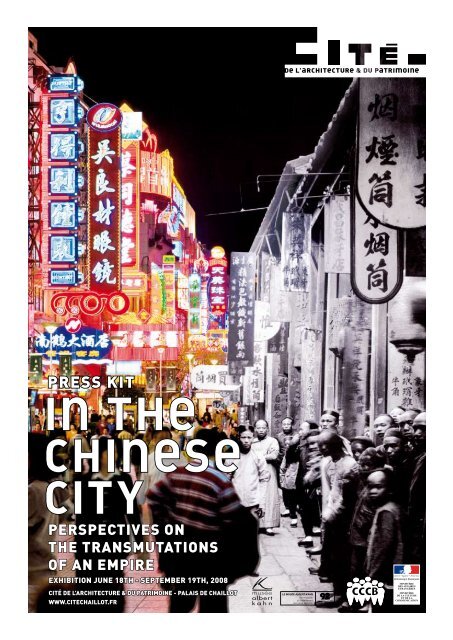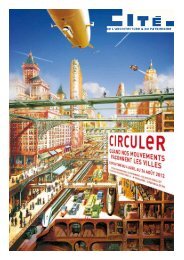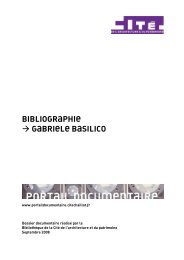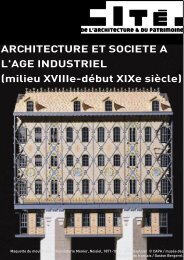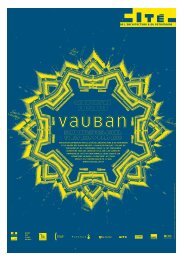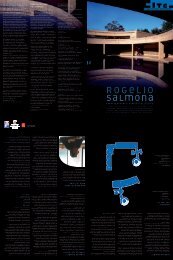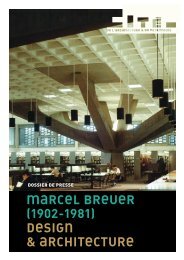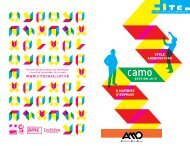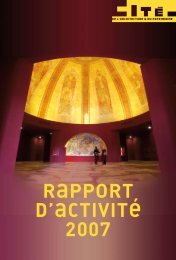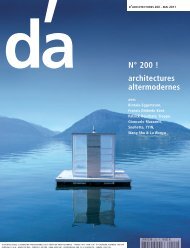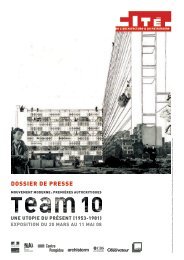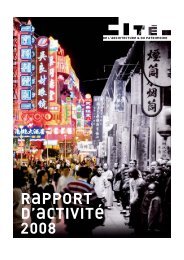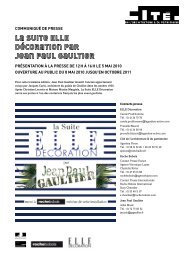in the Chinese City - Cité de l'architecture & du patrimoine
in the Chinese City - Cité de l'architecture & du patrimoine
in the Chinese City - Cité de l'architecture & du patrimoine
Create successful ePaper yourself
Turn your PDF publications into a flip-book with our unique Google optimized e-Paper software.
PRESS KIT<br />
<strong>in</strong> <strong>the</strong><br />
Ch<strong>in</strong>ese<br />
<strong>City</strong><br />
perspectives on<br />
<strong>the</strong> transmutations<br />
of an empire<br />
Exhibition June 18th - September 19th, 2008<br />
Cité <strong>de</strong> l’architecture & <strong>du</strong> patrimo<strong>in</strong>e - Palais <strong>de</strong> Chaillot<br />
www.citechaillot.fr
PRESS KIT<br />
<strong>in</strong> <strong>the</strong><br />
Ch<strong>in</strong>ese <strong>City</strong><br />
perspectives<br />
of <strong>the</strong> tr ansmutations<br />
of an Empire<br />
Exhibition June 18th<br />
September 19th, 2008<br />
Temporary Exhibition Galleries<br />
Exhibition co-pro<strong>du</strong>ced by <strong>the</strong> Cité and <strong>the</strong> cCCb<br />
Positions<br />
PORTRAIT OF A NEW GENERATION<br />
OF CHINESE ARCHITECTS<br />
EXHIBITION JUNE 18TH<br />
SEPTEMBER 7TH, 2008<br />
Current events Galleries - level 1<br />
Cité <strong>de</strong> l’architecture & <strong>du</strong> patrimo<strong>in</strong>e<br />
Palais <strong>de</strong> Chaillot<br />
1 place <strong>du</strong> Trocadéro, 75116 Paris<br />
Information: 01 58 51 52 00<br />
www.citechaillot.fr<br />
Press Contacts<br />
Cité <strong>de</strong> l’architecture & <strong>du</strong> patrimo<strong>in</strong>e<br />
Agost<strong>in</strong>a P<strong>in</strong>on<br />
Tél. 01 58 51 52 85 / 06 03 59 55 26<br />
ap<strong>in</strong>on@citechaillot.fr<br />
Opus 64<br />
Valérie Samuel et Arnaud Pa<strong>in</strong><br />
Tél. 01 40 26 77 94<br />
a.pa<strong>in</strong>@opus64.com
The exhibition, “In <strong>the</strong> ch<strong>in</strong>ese <strong>City</strong>: perspectives on <strong>the</strong> transmutations<br />
of an empire” is quite naturally <strong>in</strong>fused with <strong>the</strong> enthusiasm and<br />
uncerta<strong>in</strong>ty surround<strong>in</strong>g <strong>the</strong> com<strong>in</strong>g Beij<strong>in</strong>g Olympic Games throughout<br />
<strong>the</strong> country, and more particularly <strong>in</strong> cities, where a constructive<br />
effervescence, unprece<strong>de</strong>nted <strong>in</strong> mo<strong>de</strong>rn human history by its size and<br />
swiftness, holds sway.<br />
On May 12th, 2008 a powerful magnitu<strong>de</strong> 8 earthquake ravaged <strong>the</strong><br />
center of <strong>the</strong> Sichuan region, near Cheng<strong>du</strong>, followed by several<br />
<strong>in</strong>tense aftershocks. Ch<strong>in</strong>a’s frailty and vulnerability are, alongsi<strong>de</strong> its<br />
magnificence and beauty, at <strong>the</strong> heart of this exhibition.<br />
The human, social, economic, and cultural consequences of such a<br />
catastrophe, and <strong>the</strong> threat it cont<strong>in</strong>ues to pose for <strong>the</strong> great river<br />
valleys, has become, <strong>in</strong>evitably, <strong>the</strong> canvas for our thoughts.<br />
For all <strong>the</strong> exhibition’s authors and participants, <strong>the</strong> dynamism carried<br />
by <strong>the</strong> Beij<strong>in</strong>g Games has given way to sadness and a <strong>de</strong>sire to be closer<br />
to our friends, over <strong>the</strong>re.
In <strong>the</strong> ch<strong>in</strong>ese city<br />
“In <strong>the</strong> Ch<strong>in</strong>ese <strong>City</strong>:” <strong>the</strong> subject is not lack<strong>in</strong>g <strong>in</strong> ambition. Exhibit<strong>in</strong>g Ch<strong>in</strong>ese cities,<br />
subject to such rhythms for <strong>the</strong> past two <strong>de</strong>ca<strong>de</strong>s that it is hard to know what to focus<br />
on: apprehension, jubilation <strong>in</strong> <strong>the</strong> face of <strong>the</strong> ability to transform, <strong>in</strong>novative quality,<br />
<strong>de</strong>solation <strong>in</strong> <strong>the</strong> face of <strong>the</strong> magnitu<strong>de</strong> of <strong>de</strong>struction, pollution... In this, our ambition<br />
is ak<strong>in</strong> to that of a stalker ly<strong>in</strong>g <strong>in</strong> wait. It is an exercise <strong>in</strong> watch<strong>in</strong>g: br<strong>in</strong>g<strong>in</strong>g <strong>in</strong>to view<br />
<strong>the</strong> words and voices of multiple po<strong>in</strong>ts of view, participat<strong>in</strong>g <strong>in</strong> that slow process of<br />
<strong>de</strong>cod<strong>in</strong>g th<strong>in</strong>gs, and <strong>in</strong> <strong>the</strong> contradictory <strong>de</strong>scriptions of situations, sift<strong>in</strong>g out questions<br />
and analysis. Because <strong>in</strong> this, we are conv<strong>in</strong>ced, like all those we have led to Ch<strong>in</strong>a,<br />
beyond bor<strong>de</strong>rs we share common questions: how do we conceive today’s liv<strong>in</strong>g cities<br />
and for <strong>de</strong>ca<strong>de</strong>s to come, what ability does architecture have to br<strong>in</strong>g to life yesterday’s<br />
heritage and that which will make us proud tomorrow, and to this end, what tools,<br />
what techniques, what experiences should we share for ever more <strong>de</strong>nsely populated<br />
metropolises Does not <strong>the</strong> urbanity of relations beg<strong>in</strong>, <strong>in</strong> Ch<strong>in</strong>ese, with <strong>the</strong> i<strong>de</strong>ogram<br />
assembl<strong>in</strong>g <strong>the</strong> digit “2” (<strong>the</strong> plural) and <strong>the</strong> character “man”<br />
Mention<strong>in</strong>g plurality of light<strong>in</strong>g and impressions br<strong>in</strong>gs to m<strong>in</strong>d movies and pictures.<br />
In this respect, we are particularly pleased to share this adventure with <strong>the</strong> Centre<br />
<strong>de</strong> cultura contemporània <strong>de</strong> Barcelona, <strong>in</strong>timately acqua<strong>in</strong>ted with cross-cutt<strong>in</strong>g<br />
multimedia subjects, with whom we express our jo<strong>in</strong>t <strong>de</strong>sire to go beyond <strong>the</strong> bor<strong>de</strong>rs of<br />
Europe and merge talents.<br />
For <strong>the</strong> first time <strong>in</strong> Europe, marvelous objects from Ch<strong>in</strong>a - a 100 square meter (1076<br />
sq. ft.) mo<strong>de</strong>l of <strong>the</strong> city of Beij<strong>in</strong>g from <strong>the</strong> end of <strong>the</strong> 20th century, antique mo<strong>de</strong>ls of<br />
traditional woo<strong>de</strong>n architecture, historical bl<strong>in</strong>d stamp<strong>in</strong>g of <strong>the</strong> Suzhou (P<strong>in</strong>gjiang at<br />
<strong>the</strong> time) stele - are highlighted next to works held <strong>in</strong> our museums, next to mo<strong>de</strong>ls of<br />
ambitious contemporary projects.<br />
Present<strong>in</strong>g <strong>the</strong>se images, mo<strong>de</strong>ls, and films of Ch<strong>in</strong>a would have been impossible<br />
without Ch<strong>in</strong>a.<br />
It is <strong>the</strong> fruit of a lengthy process led by Frédéric E<strong>de</strong>lmann, <strong>the</strong> exhibition’s General<br />
Curator, assisted by Françoise Ged, head of <strong>the</strong> Mo<strong>de</strong>rn Ch<strong>in</strong>ese Architecture<br />
Observatory, created <strong>in</strong> 1997. May <strong>the</strong>se signs of friendship and trust on behalf of all<br />
<strong>the</strong> Ch<strong>in</strong>ese <strong>de</strong>signers, professionals, and <strong>in</strong>stitutions, special partners like Tongji<br />
University and today’s len<strong>de</strong>rs, allow us to progress <strong>in</strong> our mutual needs for shar<strong>in</strong>g and<br />
knowledge.<br />
François <strong>de</strong> Mazières<br />
Prési<strong>de</strong>nt <strong>de</strong> la Cité <strong>de</strong> l’architecture & <strong>du</strong> patrimo<strong>in</strong>e
The Great Transformation<br />
One day, economists and historians will be able to expla<strong>in</strong> <strong>the</strong> brutal transformation<br />
Ch<strong>in</strong>a is currently un<strong>de</strong>rgo<strong>in</strong>g. It is a country where almost everyth<strong>in</strong>g, if you don’t look<br />
more closely, seems to be less than ten years old. Op<strong>in</strong>ions differ between those who see<br />
<strong>the</strong> Ch<strong>in</strong>ese process as a large-scale repetition of past processes <strong>in</strong> <strong>the</strong> <strong>de</strong>velopment of<br />
capitalism and those who believe a different mo<strong>de</strong>l, whose <strong>de</strong>ployment obeys laws we<br />
do not yet fully un<strong>de</strong>rstand, could be <strong>in</strong>cubat<strong>in</strong>g. However, no one dares <strong>de</strong>clare <strong>the</strong> fate<br />
of this mo<strong>de</strong>l that has changed <strong>the</strong> face of <strong>the</strong> country <strong>in</strong> <strong>the</strong> last fifteen years, apply<strong>in</strong>g<br />
<strong>the</strong> creative <strong>de</strong>struction pr<strong>in</strong>ciple at a break-neck pace, exceed<strong>in</strong>g Marx’s most visionary<br />
predictions.<br />
In <strong>the</strong> beg<strong>in</strong>n<strong>in</strong>g <strong>the</strong>re were ... <strong>de</strong>mographics. One billion, three hundred million people<br />
make up an <strong>in</strong>commensurable force, particularly if <strong>the</strong>y are ready for anyth<strong>in</strong>g, tra<strong>in</strong>ed<br />
<strong>in</strong> a secular culture of submission and respect for hierarchy. An unprece<strong>de</strong>nted <strong>in</strong>ternal<br />
migration: hundreds of millions of people have already left <strong>the</strong> countrysi<strong>de</strong> look<strong>in</strong>g for a<br />
job <strong>in</strong> <strong>the</strong> cities. Millions of people rema<strong>in</strong>, constitut<strong>in</strong>g a reserve army, who, when <strong>the</strong>y<br />
move, become migrants <strong>in</strong> <strong>the</strong>ir own country, ready to go anywhere to f<strong>in</strong>d work. Subject<br />
to <strong>in</strong>credible political, economic, and social pressure, <strong>the</strong> urban landscape is chang<strong>in</strong>g at a<br />
prodigious rate. All that is old is fall<strong>in</strong>g to bulldozers and excavators.<br />
Ch<strong>in</strong>ese cities have become unrecognizable for those who knew <strong>the</strong>m fifteen or twenty<br />
years ago. While this unstoppable transformation cont<strong>in</strong>ues, we thought it would be<br />
<strong>in</strong>terest<strong>in</strong>g to take a look at Ch<strong>in</strong>ese urban culture. Riffl<strong>in</strong>g through <strong>the</strong> cultural and<br />
historical roots of <strong>the</strong> Ch<strong>in</strong>ese city form<strong>in</strong>g an archeological base for <strong>the</strong> current city.<br />
Display<strong>in</strong>g <strong>the</strong> current Ch<strong>in</strong>ese city to better un<strong>de</strong>rstand <strong>the</strong> level of <strong>the</strong> great fracture<br />
tak<strong>in</strong>g place, while po<strong>in</strong>t<strong>in</strong>g out <strong>the</strong> tenuous cont<strong>in</strong>uity between <strong>the</strong> two. Therefore we<br />
exam<strong>in</strong>e some of <strong>the</strong> myths of Ch<strong>in</strong>ese urban culture, attempt<strong>in</strong>g to see how <strong>the</strong>y cont<strong>in</strong>ue<br />
<strong>in</strong>to <strong>the</strong> future.<br />
From Chongq<strong>in</strong>g (<strong>the</strong> largest city <strong>in</strong> Ch<strong>in</strong>a), which feels like ano<strong>the</strong>r planet, to Beij<strong>in</strong>g,<br />
bear<strong>in</strong>g <strong>the</strong> signs and badges of power, pass<strong>in</strong>g through Shanghai, which still feels like<br />
a bourgeois city, samples taken from <strong>the</strong> Ch<strong>in</strong>ese urban world br<strong>in</strong>g visitors closer to<br />
this apparently unlimited emerg<strong>in</strong>g power <strong>the</strong> Western world f<strong>in</strong>ds both fasc<strong>in</strong>at<strong>in</strong>g and<br />
worrisome.<br />
The urban vocation of both organiz<strong>in</strong>g <strong>in</strong>stitutions - <strong>the</strong> Cité <strong>de</strong> l’architecture & <strong>du</strong><br />
patrimo<strong>in</strong>e and <strong>the</strong> Centre <strong>de</strong> cultura contemporània <strong>de</strong> Barcelona - fully justifies this<br />
jo<strong>in</strong>t wager. Today, Ch<strong>in</strong>a rema<strong>in</strong>s largely unfamiliar <strong>in</strong> <strong>the</strong> West, where it is viewed with<br />
pre-conceived i<strong>de</strong>as, both favorable and unfavorable, that do not help un<strong>de</strong>rstand<strong>in</strong>g. The<br />
fasc<strong>in</strong>ation that Ch<strong>in</strong>a <strong>in</strong>cites <strong>in</strong> <strong>the</strong> corporate world leads one to th<strong>in</strong>k that <strong>the</strong>ir rejection<br />
of <strong>the</strong> Soviet Union was not because of communism, but because it was <strong>in</strong>efficient at<br />
exploit<strong>in</strong>g its workers. Western political lea<strong>de</strong>rs view it with fear and hesitation. Whatever<br />
<strong>the</strong> case, discourse changes <strong>de</strong>pend<strong>in</strong>g on what is highlighted: macroeconomic data,<br />
its treatment of its own citizens, or <strong>the</strong> claims of a major neo-imperialist power. In <strong>the</strong><br />
face of such confusion, this exhibition only hopes to present a series of icons, historical<br />
references, and current realities. A gra<strong>in</strong> of sand to help Europe’s citizens start penetrat<strong>in</strong>g<br />
this particular phenomenon of great urban transformation <strong>in</strong> Ch<strong>in</strong>a.<br />
Josep Ramoneda<br />
Directeur <strong>du</strong> Centre <strong>de</strong> cultura contemporània <strong>de</strong> Barcelona (CCCB)
Large-Scale Fasc<strong>in</strong>ation<br />
Megalopolises, metropolises, satellite towns, <strong>the</strong>me towns, gated communities, “green cities,”<br />
lane houses, hútòngs ... Where cities are concerned, <strong>the</strong> plural is required. That is why <strong>the</strong>re are<br />
so many “Perspectives on <strong>the</strong> transmutations of an Empire” offered by <strong>the</strong> “In <strong>the</strong> ch<strong>in</strong>ese <strong>City</strong>”<br />
exhibition <strong>de</strong>signed by Frédéric E<strong>de</strong>lmann.<br />
The frame is wi<strong>de</strong>. Very wi<strong>de</strong>. Exhibit<strong>in</strong>g contemporary cities <strong>in</strong>volves immersion <strong>in</strong> <strong>the</strong><br />
immensity of Ch<strong>in</strong>ese landscape and its history. With no pre-conceived notions, off <strong>the</strong> beaten<br />
track and far from <strong>the</strong> ready-ma<strong>de</strong> images of Ch<strong>in</strong>ese mo<strong>de</strong>rnization, <strong>the</strong> exhibition subtly<br />
<strong>in</strong>terweaves <strong>the</strong> l<strong>in</strong>ks between Ch<strong>in</strong>ese culture and <strong>the</strong> mo<strong>de</strong>rn city. Very hierarchical <strong>in</strong> days of<br />
yore, hyper-globalized today. Let’s take a moment to exam<strong>in</strong>e <strong>the</strong> word chéngshì , mean<strong>in</strong>g city<br />
<strong>in</strong> Ch<strong>in</strong>ese, <strong>the</strong> syn<strong>the</strong>sis of two words, chéng, castle, shi, market. While <strong>the</strong>re are hardly any<br />
castles left, shopp<strong>in</strong>g centers are <strong>in</strong>numerable...<br />
Five city portraits, specially filmed for <strong>the</strong> exhibition by young Ch<strong>in</strong>ese directors, supervised by<br />
Jia Zhangke, <strong>the</strong> author of Still Life, testify to <strong>the</strong> disruptions that fasc<strong>in</strong>ate so many people.<br />
Yes, <strong>in</strong> a country where rural life is still very present, <strong>the</strong> Ch<strong>in</strong>ese city is un<strong>de</strong>rgo<strong>in</strong>g a profound<br />
mutation. It is explod<strong>in</strong>g as much as it is be<strong>in</strong>g reconstituted. Density is at <strong>the</strong> heart of this<br />
great urban adventure. Mobility is an important question for <strong>in</strong>tegration <strong>in</strong> <strong>the</strong> contemporary<br />
landscape.<br />
The move from bikes to cars has also contributed to chang<strong>in</strong>g <strong>the</strong> face of <strong>the</strong> city. Giv<strong>in</strong>g rise to<br />
<strong>the</strong> proliferation of urban highways creat<strong>in</strong>g a new level, 7 meters (23 feet) high, where all <strong>the</strong><br />
traffic jams take place, just like all <strong>the</strong> travell<strong>in</strong>g shots on <strong>the</strong> city.<br />
Economic growth and <strong>in</strong>creas<strong>in</strong>g urbanization go hand <strong>in</strong> hand. Over fifty years, Ch<strong>in</strong>a’s<br />
transformation is measured by urban <strong>de</strong>mographics. Already <strong>in</strong> 2003, more than 40% of<br />
Ch<strong>in</strong>ese people (523.7 million <strong>in</strong>habitants) lived <strong>in</strong> cities, compared to only 13.6% <strong>in</strong> 1954.<br />
Ch<strong>in</strong>a currently has 37 metropolises with more than a million <strong>in</strong>habitants, as well as several<br />
megalopolises <strong>in</strong>clud<strong>in</strong>g Shanghai, boomtown with more than 15 million <strong>in</strong>habitants, Beij<strong>in</strong>g,<br />
<strong>the</strong> size of <strong>the</strong> Paris region, and Chongq<strong>in</strong>g, a megalopolis cover<strong>in</strong>g <strong>the</strong> same area as <strong>the</strong><br />
Benelux countries.<br />
As nowhere else on Earth, a certa<strong>in</strong> “museumification” accompanies this great multi-faceted<br />
mutation. Proud of its <strong>de</strong>velopment, each major city has created its own “<strong>City</strong> Plann<strong>in</strong>g<br />
Museum” free of any nostalgia (<strong>the</strong> <strong>de</strong>struction of old neighborhoods is hardly mentioned),<br />
resolutely fac<strong>in</strong>g <strong>the</strong> future.<br />
In Shanghai, for example, <strong>the</strong> build<strong>in</strong>g sits enthroned next to <strong>the</strong> town hall, as counterpo<strong>in</strong>t to<br />
<strong>the</strong> Opera, fac<strong>in</strong>g <strong>the</strong> Beaux-Arts museum. Should this be <strong>in</strong>terpreted as mean<strong>in</strong>g city plann<strong>in</strong>g<br />
is a Beaux Art “Urbanism” is a new term for <strong>the</strong> Middle K<strong>in</strong>gdom; it was first used <strong>in</strong> 1930<br />
foreshadow<strong>in</strong>g a “Great Shanghai.” Questions about <strong>the</strong> amplitu<strong>de</strong> of <strong>the</strong>se urban phenomena,<br />
like new typologies for neighborhoods<br />
and city sectors, are <strong>the</strong> issues of this exhibition, <strong>the</strong> first ever <strong>de</strong>dicated to Ch<strong>in</strong>ese cities.<br />
We remember Rem Koolhass who, with his Harvard researchers,<br />
pioneered <strong>the</strong> study of <strong>the</strong> Pearl River <strong>de</strong>lta’s rapid <strong>de</strong>velopment. Also of note, <strong>the</strong> susta<strong>in</strong>ed<br />
<strong>in</strong>terest<br />
French schools of architecture (<strong>in</strong> particular <strong>the</strong> Nantes-Malaquais-Versailles triptych) have<br />
shown <strong>in</strong> this Ch<strong>in</strong>ese urban laboratory. The 2008 Beij<strong>in</strong>g Olympic Games, with <strong>the</strong>ir imported<br />
icons and o<strong>the</strong>r major build<strong>in</strong>gs, <strong>the</strong> com<strong>in</strong>g Shanghai Universal Exhibition <strong>in</strong> 2010, both<br />
accelerat<strong>in</strong>g factors <strong>in</strong> urban transformation, are not go<strong>in</strong>g to satisfy <strong>the</strong> hunger for this urban<br />
substance.<br />
Francis Rambert<br />
Directeur <strong>de</strong> l’Institut français d’architecture
Cities of Shadow, Cities of Light<br />
In <strong>the</strong> city, <strong>in</strong> Ch<strong>in</strong>a, everyone, whe<strong>the</strong>r Ch<strong>in</strong>ese or foreigner, worker, bus<strong>in</strong>essman,<br />
or tourist, sees and un<strong>de</strong>rstands what he wants, what pleases him. Ch<strong>in</strong>a, and more<br />
especially its megalopolises, has as many faces as <strong>the</strong>re are lights and shadows <strong>in</strong> our<br />
own imag<strong>in</strong>ation - s<strong>in</strong>ologists speak of Ch<strong>in</strong>ese Y<strong>in</strong> and Yang culture: two complementary<br />
faces of <strong>the</strong> same reality.<br />
The strength of Ch<strong>in</strong>ese propaganda, as it began un<strong>de</strong>r Mao Zedong, is to have <strong>in</strong>culcated<br />
a view of Ch<strong>in</strong>a as submissive, fearful, and distorted. F<strong>in</strong>ally, today, we can approach,<br />
view, and analyze Ch<strong>in</strong>a, although still with some difficulty (first of which is <strong>the</strong> language).<br />
It is also possible to appreciate, with <strong>the</strong> ambiguous pleasure of discovery, this Ch<strong>in</strong>a<br />
pull<strong>in</strong>g ahead when we thought we were first, from with<strong>in</strong> <strong>the</strong> protective shadow of Europe<br />
or <strong>the</strong> United States.<br />
We can see it as it is. We will not attempt to answer <strong>the</strong> immense questions it is ask<strong>in</strong>g<br />
itself and us: ecology, water, energy, food, <strong>de</strong>mographics, climate... These questions are<br />
simply asked, through what we have seen, heard, and exchanged.<br />
The Olympic <strong>de</strong>al and <strong>the</strong> revival of <strong>the</strong> Tibet issue have changed <strong>the</strong> ways this exhibition<br />
may be viewed, awaken<strong>in</strong>g fears and mistrust that <strong>the</strong> com<strong>in</strong>g necessary resolution of<br />
global problems should ren<strong>de</strong>r sterile. What is important for Westerners is to see better<br />
<strong>in</strong> or<strong>de</strong>r to better un<strong>de</strong>rstand, and, if possible, better react.<br />
What is important for Ch<strong>in</strong>a, beyond <strong>the</strong> rhetoric, is to accept to be seen and questioned<br />
for what it is, and not based on an image it struggles to ma<strong>in</strong>ta<strong>in</strong>.<br />
Only Ch<strong>in</strong>ese cities are visible here, and only a very small part of <strong>the</strong>m, whose <strong>de</strong>st<strong>in</strong>y<br />
is l<strong>in</strong>ked to an <strong>in</strong>f<strong>in</strong>itely more ancient culture, always present <strong>in</strong> texts and writ<strong>in</strong>g, but<br />
almost completely <strong>de</strong>stroyed <strong>in</strong> urban shapes and cont<strong>in</strong>uity. How did such a <strong>de</strong>structive<br />
phenomenon come <strong>in</strong>to be<strong>in</strong>g Was it <strong>in</strong>evitable What are <strong>the</strong> long-term consequences<br />
Everyone must f<strong>in</strong>d <strong>the</strong>ir own answers to this catalogue of questions.<br />
Frédéric E<strong>de</strong>lmann<br />
Commissioner
In <strong>the</strong> ch<strong>in</strong>ese city<br />
“CLOSE YOUR EYES AND SEE<br />
THE WORLD ARISE ANEW”<br />
Peter Handke (1983, Der Ch<strong>in</strong>ese <strong>de</strong>s Schmerzes<br />
[The Ch<strong>in</strong>aman of Pa<strong>in</strong>])<br />
In August <strong>the</strong> 2008 Beij<strong>in</strong>g Olympic Games will take place, followed by <strong>the</strong><br />
Shanghai Universal Exhibition <strong>in</strong> 2010. These two cities have un<strong>de</strong>rgone<br />
an architectural and urban metamorphosis unprece<strong>de</strong>nted <strong>in</strong> world<br />
history <strong>in</strong> its amplitu<strong>de</strong> and speed. A new movement has touched all of<br />
Ch<strong>in</strong>a and <strong>de</strong>eply changed <strong>the</strong> lives of hundreds of millions of <strong>in</strong>habitants.<br />
It is to this urban Ch<strong>in</strong>a that <strong>the</strong> Cité <strong>de</strong> l’architecture & <strong>du</strong> patrimo<strong>in</strong>e<br />
<strong>de</strong>dicates <strong>the</strong> “In <strong>the</strong> ch<strong>in</strong>ese city: Perspectives on <strong>the</strong> transmutations of<br />
an Empire” exhibition. The first of its k<strong>in</strong>d, its ambition is to provi<strong>de</strong> keys<br />
for un<strong>de</strong>rstand<strong>in</strong>g a phenomenon often hid<strong>de</strong>n by a tourist’s view, a sort<br />
of economic disquiet, a sort of <strong>in</strong>nocence before <strong>the</strong> mechanisms at work<br />
<strong>in</strong> <strong>the</strong> Middle K<strong>in</strong>gdom (Zhōngguó).<br />
It is a liv<strong>in</strong>g Ch<strong>in</strong>a, abound<strong>in</strong>g and surpris<strong>in</strong>g, presented from June to<br />
September 2008 on about 2000 m² (21,500 sq. feet), <strong>in</strong> temporary exhibition<br />
galleries and <strong>in</strong> one of <strong>the</strong> current affairs galleries <strong>in</strong> <strong>the</strong> <strong>City</strong> at <strong>the</strong><br />
Chaillot Palace. The <strong>City</strong> has entrusted <strong>the</strong> exhibition’s commissionership<br />
to Frédéric E<strong>de</strong>lman, a journalist at Le Mon<strong>de</strong>, assisted by Françoise Ged,<br />
head of <strong>the</strong> Contemporary Ch<strong>in</strong>ese Architecture Observatory (CCAO).<br />
Frédéric E<strong>de</strong>lmann has worked with <strong>the</strong> Observatory for ten years <strong>in</strong> its<br />
research on cities, architecture, and heritage, <strong>in</strong> conjunction with <strong>the</strong><br />
largest universities <strong>in</strong> <strong>the</strong> country. The scene <strong>de</strong>sign was <strong>de</strong>veloped by<br />
Enric Massip, a Catalan architect.<br />
The exhibition, based on a general project suggested by Frédéric<br />
E<strong>de</strong>lmann, is <strong>in</strong>spired by a phrase from Der Ch<strong>in</strong>ese <strong>de</strong>s Schmerzes [The<br />
Ch<strong>in</strong>aman of Pa<strong>in</strong>] by <strong>the</strong> Austrian writer Peter Handke: “Close your eyes<br />
and see <strong>the</strong> world arise anew.” It is broadly divi<strong>de</strong>d <strong>in</strong> three sets.<br />
The first illustrates <strong>the</strong> history of urban Ch<strong>in</strong>a and its acceleration <strong>in</strong> <strong>the</strong><br />
20th century up to <strong>the</strong> metamorphosis of <strong>the</strong> last ten years.<br />
The second set explores 6 cities, 6 megalopolises, known, like Shanghai<br />
and Beij<strong>in</strong>g, famous, like Suzhou and Xi’an, or unknown, like <strong>the</strong><br />
conurbation stretch<strong>in</strong>g from Guangzhou to Shenzhen, <strong>in</strong> <strong>the</strong> Pearl River<br />
Delta. Lastly, <strong>the</strong> vertig<strong>in</strong>ous city, Chongq<strong>in</strong>g, near <strong>the</strong> gigantic Three<br />
Gorges Dam.<br />
A third set, called “Positions: Portrait of a New Generation of Ch<strong>in</strong>ese<br />
Architects,” profiles <strong>the</strong> new generation of Ch<strong>in</strong>ese architects through<br />
around forty remarkable pro<strong>du</strong>ctions, filmed from 2003 to 2008. It is<br />
freely accessible on level 1 <strong>in</strong> <strong>the</strong> <strong>City</strong>’s current affairs galleries.
Co-pro<strong>du</strong>ced with <strong>the</strong> Centre <strong>de</strong> cultura contemporània <strong>de</strong> Barcelona<br />
(CCCB), <strong>the</strong> exhibition presents a number of major works. Some have<br />
been loaned by Ch<strong>in</strong>ese <strong>in</strong>stitutions, <strong>in</strong> particular a relief map from<br />
<strong>the</strong> Beij<strong>in</strong>g Municipal Institute of <strong>City</strong> Plann<strong>in</strong>g and Design, which has<br />
never left Ch<strong>in</strong>a before, as well as construction mo<strong>de</strong>ls on loan from<br />
Tongji University <strong>in</strong> Shanghai and Tianj<strong>in</strong> University. O<strong>the</strong>rs come<br />
from French public collections, such as <strong>the</strong> Guimet and Cernuschi<br />
museums <strong>in</strong> Paris, <strong>the</strong> Albert Kahn Departmental Museum <strong>in</strong> Boulogne-<br />
Billancourt, or private collections (Dautresme, Fava ...). A large majority<br />
of <strong>the</strong> photographs illustrat<strong>in</strong>g <strong>the</strong> subject of this urban saga come from<br />
Ch<strong>in</strong>ese photographers and are works largely unknown to <strong>the</strong> public<br />
at large. F<strong>in</strong>ally, <strong>the</strong> close collaboration with <strong>the</strong> CCCB has ad<strong>de</strong>d a<br />
significant c<strong>in</strong>ematographic dimension to <strong>the</strong> set. C<strong>in</strong>ematographer Jia<br />
Zhangke, w<strong>in</strong>ner of <strong>the</strong> Gold Lion at <strong>the</strong> 2006 Venice Film Festival for Still<br />
Life, orchestrated <strong>the</strong> work of four of his colleagues cover<strong>in</strong>g as many<br />
cities symboliz<strong>in</strong>g <strong>the</strong> contemporary metamorphosis. The CCCB teams<br />
have also provi<strong>de</strong>d <strong>the</strong>ir expertise <strong>in</strong> photography angles and audiovisual<br />
edit<strong>in</strong>g.<br />
The exhibition “In <strong>the</strong> ch<strong>in</strong>ese city: Perspectives on <strong>the</strong> transmutations of<br />
an Empire” will be presented from November 4th, 2008 to February 22nd,<br />
2009 at <strong>the</strong> Centre <strong>de</strong> cultura contemporània <strong>de</strong> Barcelona (CCCB).<br />
The “Positions” exhibition will be on display at <strong>the</strong> Catalonia Architecture<br />
College (CAC) from November 4th, 2008.
Perspectives on <strong>the</strong><br />
transmutations of an Empire<br />
OBJECTS, DOCUMENTS, & WORKS PRESENTED<br />
The exhibition is organized around <strong>the</strong> presentation of archeological<br />
items (objects, books, and cloth<strong>in</strong>g), recent objects and mo<strong>de</strong>ls, archive<br />
images, and contemporary creations. Antique and contemporary works<br />
come from public and private collections. Their purpose is to show <strong>the</strong><br />
culture <strong>in</strong> which <strong>the</strong> urban universe <strong>de</strong>veloped.<br />
The documentary work, <strong>in</strong>tegrat<strong>in</strong>g graphic works, archive images,<br />
and contemporary photographs, is often presented <strong>in</strong> multimedia and<br />
audiovisual format. For this purpose, <strong>the</strong> CCCB has created a number<br />
of montages whose e<strong>du</strong>cational purpose does not exclu<strong>de</strong> an es<strong>the</strong>tic,<br />
or even playful, dimension.<br />
For <strong>the</strong> contemporary period, <strong>the</strong> specific contribution of <strong>the</strong> plastic<br />
arts (photographs) and <strong>in</strong><strong>de</strong>pen<strong>de</strong>nt films is also a major component<br />
of <strong>the</strong> exhibition. For <strong>the</strong> greatest part, <strong>the</strong> photos have been taken<br />
by Ch<strong>in</strong>ese photographers, and are presented for <strong>the</strong>ir documentary<br />
value. Jia Zhangke, <strong>the</strong> famous director of <strong>the</strong> film, Still Life (Sanjia Lao<br />
ren), portrait of life around <strong>the</strong> Three Georges Dam, has coord<strong>in</strong>ated<br />
<strong>the</strong> film<strong>in</strong>g of 5 short subjects about 5 cities for <strong>the</strong> exhibition, <strong>in</strong>clud<strong>in</strong>g<br />
one he filmed himself:<br />
Suzhou - Cry Me a River, by Jia Zhangke<br />
Xi’an - Outsi<strong>de</strong> Xi’an by Chen Tao<br />
Chongq<strong>in</strong>g - Wait by Peng Tao<br />
Canton - New Year by Li Hongqi.<br />
Shanghai - Be<strong>in</strong>g and Noth<strong>in</strong>gless by Han Jie.<br />
10
CIRCUIT<br />
The circuit, unified by <strong>the</strong> notion of change (huá, 化 , biànhuà 变 化 , yì 易 )is<br />
broken down <strong>in</strong>to fifteen differently sized, autonomous spaces or mo<strong>du</strong>les<br />
correspond<strong>in</strong>g to <strong>the</strong> exhibition’s chapters. The <strong>the</strong>matic mo<strong>du</strong>les are<br />
l<strong>in</strong>ked to a Ch<strong>in</strong>ese word or concept; o<strong>the</strong>r cities are presented through<br />
one of <strong>the</strong>ir significant characteristics.<br />
GENERAL AMBIANCE<br />
The general ambiance created by Enric Massip, an architect from<br />
Catalonia, is somber and frugal. The layout of each room contributes<br />
to lead<strong>in</strong>g <strong>the</strong> audience through a highly charged atmosphere that does<br />
not seek, however, to imitate or paraphrase <strong>the</strong> Ch<strong>in</strong>ese universe.<br />
Here, <strong>the</strong> symbolic mean<strong>in</strong>g of thresholds, <strong>in</strong> <strong>the</strong> break down Ch<strong>in</strong>ese<br />
of spaces, corresponds to visual fractures. Moreover, <strong>the</strong> scene <strong>de</strong>sign<br />
differentiates each mo<strong>du</strong>le, each <strong>the</strong>me, with an orig<strong>in</strong>al, s<strong>in</strong>gular<br />
system. The exhibition’s graphics, created by <strong>the</strong> Catalan workshop<br />
“mm !!, Monica Mestanza” also splits up <strong>the</strong> circuit by emphasiz<strong>in</strong>g <strong>the</strong><br />
importance of projected Ch<strong>in</strong>ese characters announc<strong>in</strong>g and highlight<strong>in</strong>g<br />
each <strong>the</strong>me.<br />
The spaces are <strong>in</strong><strong>de</strong>pen<strong>de</strong>nt of each o<strong>the</strong>r and follow <strong>the</strong>ir own chronology.<br />
They focus on a Ch<strong>in</strong>ese character, or two or more characters <strong>in</strong> parallel,<br />
opposition, or resonance. These characters display a multifaceted view <strong>in</strong><br />
<strong>the</strong> permanence or <strong>de</strong>velopment of each notion. For example, <strong>in</strong> <strong>the</strong> space<br />
about territory, 地 dì (Earth) 人 rén (population) serve as <strong>in</strong>tro<strong>du</strong>ction.<br />
The <strong>the</strong>matic spaces have <strong>the</strong>ir own scene <strong>de</strong>sign adapted to <strong>the</strong> rich<br />
content <strong>the</strong>y present. Some spaces have a spectacular, dynamic setup<br />
us<strong>in</strong>g various audiovisual mechanisms: <strong>the</strong> gar<strong>de</strong>n, Q<strong>in</strong>gm<strong>in</strong>g Shanghetu,<br />
water, <strong>de</strong>struction.<br />
The five cities are thought of as spatial markers: five boxes where short<br />
subjects by Ch<strong>in</strong>ese film makers are projected. This urban circuit ends <strong>in</strong><br />
<strong>the</strong> f<strong>in</strong>al space where a relief map of Beij<strong>in</strong>g is presented, on loan from<br />
<strong>the</strong> city’s <strong>City</strong> Plann<strong>in</strong>g Institute and which has never left <strong>the</strong> country<br />
before.<br />
The exposition is <strong>de</strong>eply marked by its cross-cutt<strong>in</strong>g nature, broach<strong>in</strong>g<br />
major <strong>the</strong>mes like writ<strong>in</strong>g, art history, history of science, religion,<br />
hydrological and land <strong>de</strong>velopment problems, daily life, etc., <strong>in</strong> so far<br />
as <strong>the</strong>y facilitate un<strong>de</strong>rstand<strong>in</strong>g <strong>the</strong> various dimensions of heritage,<br />
architecture, and urbanism.<br />
At <strong>the</strong> end of <strong>the</strong> exhibition, a series of isolated “<strong>the</strong>aters” where visitors<br />
watch documentaries exam<strong>in</strong><strong>in</strong>g <strong>in</strong> <strong>de</strong>pth social and cultural <strong>the</strong>mes that<br />
complement <strong>the</strong> urban dimensions form<strong>in</strong>g <strong>the</strong> ma<strong>in</strong> <strong>the</strong>me.<br />
11
THE SPACES<br />
ONE THEME, ONE SPACE<br />
Each space <strong>in</strong>clu<strong>de</strong>s:<br />
1) a general <strong>de</strong>f<strong>in</strong>ition<br />
2) objects and documents.<br />
Prologue<br />
Suzhou (Jiangsu prov<strong>in</strong>ce) Steles<br />
These are repro<strong>du</strong>ctions of six large steles, historically quite important,<br />
whose orig<strong>in</strong>als may be found <strong>in</strong> Confucius’ former temple and <strong>in</strong> <strong>the</strong><br />
Chenghuang Temple <strong>in</strong> “Ch<strong>in</strong>a’s Venice,” <strong>the</strong> imperial city famous for<br />
its gar<strong>de</strong>ns and canals. These six emblematic elements syn<strong>the</strong>size <strong>the</strong><br />
birth and <strong>de</strong>velopment of cities un<strong>de</strong>r <strong>the</strong> old empire.<br />
Stele 1<br />
Map of P<strong>in</strong>gjiang, city map engraved <strong>in</strong> 1229. Lightly retouched <strong>in</strong> 1917.<br />
There is at least one orig<strong>in</strong>al <strong>in</strong> <strong>the</strong> United States.<br />
Stele 2<br />
Geographic map of Ch<strong>in</strong>a engraved <strong>in</strong> 1247.<br />
Stele 3<br />
Celestial chart, engraved <strong>in</strong> 1247 (Song dynasty) <strong>de</strong>pict<strong>in</strong>g a 1193 survey.<br />
Stele 4<br />
Imperial family tree engraved <strong>in</strong> 1247.<br />
Stele 5<br />
Map of Gusu (former name of Suzhou) engraved <strong>in</strong> 1783.<br />
Stele 6<br />
Canal water circuit. This is a technical “document” essential to <strong>the</strong> history<br />
of hydrography, engraved <strong>in</strong> 1797.<br />
Espace 1<br />
THE ZITHER AND THE KITE<br />
yuan 园 (gar<strong>de</strong>n)<br />
The i<strong>de</strong>a is to remove visitors from <strong>the</strong>ir Western, Parisian ambience<br />
and immediately immerse <strong>the</strong>m <strong>in</strong> a Ch<strong>in</strong>ese ambience. In this respect,<br />
<strong>the</strong> gar<strong>de</strong>n symbolizes Ch<strong>in</strong>ese culture. The traditional Ch<strong>in</strong>ese gar<strong>de</strong>n<br />
from <strong>the</strong> Yangzi River Delta region is a gar<strong>de</strong>n for <strong>the</strong> literati, suitable for<br />
poetry, philosophy, meet<strong>in</strong>g with friends, and calligraphy. Today, <strong>the</strong>se<br />
gar<strong>de</strong>ns are also large city parks where <strong>in</strong>habitants participate <strong>in</strong> a large<br />
number of sports: kit<strong>in</strong>g, dance, tai-chi...<br />
This room is place of preparation. It lays out <strong>the</strong> characteristics of a Ch<strong>in</strong>ese<br />
gar<strong>de</strong>n with sets of frames / open<strong>in</strong>gs / screen walls / promena<strong>de</strong>s,<br />
and four w<strong>in</strong>dows <strong>in</strong> <strong>the</strong> form of vi<strong>de</strong>os represent<strong>in</strong>g a musician play<strong>in</strong>g<br />
a zi<strong>the</strong>r <strong>in</strong> a Ch<strong>in</strong>ese gar<strong>de</strong>n; a city park <strong>in</strong> Shenzhen where crowds play<br />
with kites (“zi<strong>the</strong>r of <strong>the</strong> w<strong>in</strong>d” <strong>in</strong> Ch<strong>in</strong>ese); perform tai-chi, and dance.<br />
The images are brought toge<strong>the</strong>r through sound.<br />
12
SPACE 2<br />
L’empire <strong>de</strong>s signes<br />
Zi 字 (character)<br />
Wen 文 (writ<strong>in</strong>g, culture)<br />
General Pr<strong>in</strong>ciple<br />
This first chapter on urban culture and history is <strong>the</strong> explanation of Peter<br />
Handke’s epigraph “Close your eyes and see <strong>the</strong> world arise anew” (Der<br />
Ch<strong>in</strong>ese <strong>de</strong>s Schmerzes [The Ch<strong>in</strong>aman of Pa<strong>in</strong>], 1983)<br />
It connects writ<strong>in</strong>g (culture, calligraphy, poetry) and space (<strong>the</strong> city, <strong>the</strong><br />
street, architecture, gar<strong>de</strong>ns)<br />
It has several goals: highlight <strong>the</strong> omnipresence of writ<strong>in</strong>g <strong>in</strong> <strong>the</strong> architectural<br />
universe, br<strong>in</strong>g about <strong>the</strong> <strong>in</strong>stitutive discovery of <strong>the</strong> relationship between<br />
<strong>the</strong> spatial conception and text creation and <strong>the</strong> characters compos<strong>in</strong>g<br />
those texts; memorization mechanisms that (partially) condition spatial<br />
perception; highlight writ<strong>in</strong>g and <strong>the</strong> music of <strong>the</strong> language (sounds, tones,<br />
...) ; present a short series of characters (12 to 20) key to each room, and<br />
through <strong>the</strong>m, <strong>the</strong> exhibition’s organiz<strong>in</strong>g pr<strong>in</strong>ciple.<br />
Documents and Objects<br />
Theme 1<br />
L<strong>in</strong>k between spatial perception and writ<strong>in</strong>g<br />
Xi’an engraved stele (Guimet Museum).<br />
Terra cotta funeral bricks (Cernuschi Museum).<br />
Seals (Dautresme Collection).<br />
Writ<strong>in</strong>g mach<strong>in</strong>e (Arts & In<strong>du</strong>stry)<br />
Vidéo n°3 : Encounters between writ<strong>in</strong>g space and urban space.<br />
Theme 2<br />
Writ<strong>in</strong>g’s dynamic and ephemeral nature<br />
Vi<strong>de</strong>o no. 4: Learn<strong>in</strong>g Ch<strong>in</strong>ese characters seems to <strong>in</strong>volve different areas<br />
of <strong>the</strong> bra<strong>in</strong> than learn<strong>in</strong>g <strong>the</strong> Lat<strong>in</strong> alphabet.<br />
Vidéo n°5 : Vi<strong>de</strong>o no. 5: Ephemeral calligraphy, Beihai Park (Beij<strong>in</strong>g).<br />
Theme 3<br />
Exhibition Map Presentation<br />
Vi<strong>de</strong>o no. 6: Gett<strong>in</strong>g lost <strong>in</strong> <strong>the</strong> exhibition. F<strong>in</strong>d<strong>in</strong>g your way around <strong>the</strong><br />
exhibition.<br />
13
SPACE 3<br />
SUZHOU 苏 州<br />
RECONSTRUCTED PAST<br />
The first of six spaces <strong>de</strong>dicated to <strong>the</strong> cities. The set <strong>de</strong>dicated to Suzhou<br />
is also, by its structure, a reference area. Here <strong>the</strong> historical specificity of<br />
Ch<strong>in</strong>a’s major cities is precisely summarized.<br />
Contrast<strong>in</strong>g with Suzhou, <strong>the</strong> imperial city, at <strong>the</strong> end of <strong>the</strong> circuit is<br />
Beij<strong>in</strong>g, <strong>the</strong> capital city. In<strong>de</strong>ed, only Xi’an could have been chosen for<br />
<strong>the</strong> same emblematic role. The “Venice of <strong>the</strong> East” offers a remarkable<br />
cont<strong>in</strong>uity <strong>in</strong> historical data, ma<strong>in</strong>ly from <strong>the</strong> Song Dynasty (10th-13th<br />
centuries) even though its orig<strong>in</strong>s go back to <strong>the</strong> 6th century before <strong>the</strong><br />
common era when it was <strong>the</strong> capital of <strong>the</strong> Wu Dynasty.<br />
The six large steles from Confucius’ Temple and from Chenghuang,<br />
replicas of which are presented at <strong>the</strong> exhibition entrance like so<br />
many heralds, also <strong>de</strong>cl<strong>in</strong>e several major issues presented throughout<br />
<strong>the</strong> exhibition. The map of <strong>the</strong> city and its canals, celestial chart,<br />
current organization for canal ma<strong>in</strong>tenance, and lastly adm<strong>in</strong>istrative<br />
organization, are echoed throughout <strong>the</strong> space, ma<strong>in</strong>ly through a series<br />
of photos, referr<strong>in</strong>g to four periods: 19th century Suzhou, practically<br />
unchanged s<strong>in</strong>ce <strong>the</strong> 13th century; Suzhou of <strong>the</strong> first mo<strong>de</strong>rnization<br />
that led to an astonish<strong>in</strong>g modification of <strong>the</strong> stele map <strong>in</strong> 1917 (whose<br />
rubb<strong>in</strong>g is held by <strong>the</strong> Library of Congress); Maoist Suzhou <strong>du</strong>r<strong>in</strong>g which<br />
<strong>in</strong><strong>du</strong>stry <strong>in</strong>va<strong>de</strong>d this literary city; and, lastly renovated Suzhou s<strong>in</strong>ce <strong>the</strong><br />
end of <strong>the</strong> 1990s and <strong>the</strong> creation of two economic zones to <strong>the</strong> east and<br />
west.<br />
Documents and Objects<br />
Local monographs (Gra<strong>du</strong>ate Institute for Ch<strong>in</strong>ese Studies) P<strong>in</strong>gjiang<br />
map stamp (Tongji University).<br />
Photographies aériennes, photographies anciennes retraçant l’histoire<br />
<strong>de</strong> la ville .<br />
Vi<strong>de</strong>o no. 7: The Rooster of Nanxun (Zhejiang).<br />
Vi<strong>de</strong>o no. 8: Weidaoguan Taoist Temple <strong>in</strong> Suzhou.<br />
Vi<strong>de</strong>o no. 9: Cry Me a River, film about Suzhou by Jia Zhangke.<br />
14
SPACE 4<br />
Q<strong>in</strong>gm<strong>in</strong>g Shanghetu<br />
Vi<strong>de</strong>o no. 11: cont<strong>in</strong>uous projection on a curved structure of <strong>the</strong> silk scroll<br />
“Life Along <strong>the</strong> River at Q<strong>in</strong>gm<strong>in</strong>g” (Q<strong>in</strong>gm<strong>in</strong>g Shanghetu). This version<br />
comes from <strong>the</strong> Palace National Museum <strong>in</strong> Taipei. It was created by<br />
court pa<strong>in</strong>ters <strong>in</strong> <strong>the</strong> 18th century, mo<strong>de</strong>led on <strong>the</strong> famous pa<strong>in</strong>t<strong>in</strong>g by<br />
Zhang Ze<strong>du</strong>an (12th century).<br />
SPACE 5<br />
XI’AN 西 安<br />
THE ARCHEOLOGY INDUSTRY<br />
Former capital un<strong>de</strong>r <strong>the</strong> name Chang’an, <strong>the</strong> old Xi’an had rema<strong>in</strong>ed<br />
relatively protected <strong>in</strong> spite of rapid growth and <strong>in</strong><strong>du</strong>strialization as<br />
massive as it is pollut<strong>in</strong>g. The city’s urban and architectural reality has<br />
changed paradoxically s<strong>in</strong>ce be<strong>in</strong>g listed by Unesco. In less than 10<br />
years, almost <strong>the</strong> entire city <strong>in</strong>si<strong>de</strong> <strong>the</strong> walls (rebuilt ra<strong>the</strong>r than restored<br />
on <strong>the</strong> old foundations) was <strong>de</strong>stroyed. Almost <strong>the</strong> only survivor,<br />
<strong>the</strong> Muslim neighborhood, is soon to be mo<strong>de</strong>rnized <strong>in</strong> turn. Only a few<br />
monuments rema<strong>in</strong>: <strong>the</strong> bell tower alone <strong>in</strong> <strong>the</strong> middle of a crossroads,<br />
<strong>the</strong> stele gar<strong>de</strong>n (Confucius’ Temple), <strong>the</strong> great and little mosques...<br />
Documents and Objects<br />
Local monographs (Gra<strong>du</strong>ate Institute for Ch<strong>in</strong>ese Studies) Aerial photographs,<br />
old photographs of monuments, <strong>the</strong> current tourist <strong>in</strong><strong>du</strong>stry.<br />
Vi<strong>de</strong>o no. 10: Outsi<strong>de</strong> Xi’an, a film about Xi’an by Chen Tao.<br />
SPACE 6<br />
EARTH, SKY, AND MAN<br />
Di 地 (earth)<br />
Tian 天 (sky)<br />
Ren 人 (man)<br />
This room evokes <strong>the</strong> notion of earth (dì) and <strong>the</strong> Ch<strong>in</strong>ese way of<br />
perceiv<strong>in</strong>g, represent<strong>in</strong>g, and measur<strong>in</strong>g territory from <strong>the</strong> beg<strong>in</strong>n<strong>in</strong>gs<br />
of <strong>the</strong> Empire to <strong>the</strong> current Popular Republic. It shows <strong>the</strong> evolution<br />
<strong>in</strong> territorial magnitu<strong>de</strong> for comprehend<strong>in</strong>g its <strong>de</strong>velopment from <strong>the</strong><br />
past until today. Lastly, physical and human geography prompts <strong>the</strong><br />
realization of <strong>the</strong> country’s natural and <strong>de</strong>mographic imbalances.<br />
Documents and Objects<br />
These i<strong>de</strong>as are presented through <strong>the</strong> creation of a big book of old<br />
and recent Ch<strong>in</strong>ese maps of <strong>the</strong> Earth and its representation, and<br />
photographs by Ch<strong>in</strong>ese photographers on territorial structur<strong>in</strong>g from<br />
yesterday and today, <strong>in</strong>frastructures, <strong>the</strong> weight of man, work, and<br />
population movements ...<br />
15
SPACE 7<br />
BENEVOLENT WATER, ANGRY WATER<br />
Shui 水 (water)<br />
This space presents <strong>the</strong> importance of water <strong>in</strong> Ch<strong>in</strong>ese civilization,<br />
daily life, territory, and cities <strong>in</strong> its two contradictory aspects:<br />
The water that, on ol<strong>de</strong>r maps, seems to isolate Ch<strong>in</strong>a, <strong>the</strong> ocean where<br />
junks were lost, <strong>the</strong> water that must be fought (tow<strong>in</strong>g boats on rivers),<br />
<strong>de</strong>vastat<strong>in</strong>g floodwaters, <strong>the</strong> lack of water and droughts, polluted<br />
water... Contrast<strong>in</strong>g with water as a vital, <strong>in</strong>tegral pr<strong>in</strong>ciple of urban<br />
spaces (sou<strong>the</strong>rn water cities) for commerce and human relations<br />
(bridges), water as <strong>the</strong> primordial element for transportation, water<br />
as energy pro<strong>du</strong>cer.<br />
These two aspects, <strong>in</strong>evitably, comb<strong>in</strong>ed with <strong>the</strong> country’s size and<br />
geography, shape <strong>the</strong> countrysi<strong>de</strong>, organize life, and <strong>de</strong>f<strong>in</strong>e major political<br />
issues. Water becomes <strong>the</strong> means for territorial <strong>de</strong>velopment and<br />
<strong>in</strong>ventions: canals and <strong>the</strong>ir <strong>de</strong>rivations, un<strong>de</strong>rground water networks<br />
<strong>in</strong> <strong>the</strong> north-east (Turfan), urban water reservoirs, dams, network of<br />
bridges <strong>in</strong> <strong>the</strong> Pearl River Delta.<br />
Vi<strong>de</strong>o no. 12: The Three Gorges Dam: Reality and Propaganda<br />
This space has been built symmetrically: two oppos<strong>in</strong>g screen walls br<strong>in</strong>g<br />
<strong>the</strong> double nature of water face to face present<strong>in</strong>g two films of clips.<br />
Vi<strong>de</strong>o no. 13: Water: shore of <strong>de</strong>ath, shore of life<br />
Espace 8<br />
chongq<strong>in</strong>g 重 庆<br />
WITH STRENGTH OF BODY<br />
No doubt, currently <strong>the</strong> most impressive city by its growth, location, and<br />
<strong>the</strong> number of problems it faces. A geographically hostile and ungrateful<br />
city, Chongq<strong>in</strong>g is one of <strong>the</strong> largest economic centers <strong>in</strong> Ch<strong>in</strong>a. This<br />
space is organized around <strong>the</strong> bangbang figure, omnipresent porters<br />
(<strong>the</strong>re are three to four hundred thousand <strong>in</strong> <strong>the</strong> city).<br />
Documents and Objects<br />
Local monographs (Gra<strong>du</strong>ate Institute for Ch<strong>in</strong>ese Studies) Old<br />
photographs and aerial photographs. Interview with a porter and<br />
contemporary photographs.<br />
Vi<strong>de</strong>o no. 14: Wait, a film by Peng Tao.<br />
16
SPACE 9<br />
Fengshui, THE POTENCY OF TRADITION<br />
Fengshui 风 水 (w<strong>in</strong>d and water; traditional geomancy)<br />
The impact of fengshui on construction, orientation of tombs, houses,<br />
cities. From concrete examples, we show how historical construction<br />
and town plann<strong>in</strong>g observe a set of co<strong>de</strong>s and standards, whereas<br />
today’s fengshui has left symbolism and common sense, to become an<br />
agglomeration of superstitions disconnected from <strong>the</strong> past.<br />
Documents and Objects<br />
Theme 1: <strong>de</strong>ath<br />
Funeral brick (Sa<strong>in</strong>t Denis Museum of History).<br />
Watch tower (Guimet Museum)<br />
Theme 2 : fengshui ritual objects<br />
Luban J<strong>in</strong>g, book of Luban, Luban’s rules, and Luban’s statuettes.<br />
Hexagonal diagram, wands, muban.<br />
Geomancy compass ( 罗 盘 , luōpán) and o<strong>the</strong>r measur<strong>in</strong>g <strong>in</strong>struments<br />
(Guimet Museum, Private Collections).<br />
Photographs of build<strong>in</strong>gs, tombs, villages, cities build accord<strong>in</strong>g to<br />
fengshui rules.<br />
Vi<strong>de</strong>o no. 16: Film about an old fengshui master.<br />
Theme 3 : Fengshui today<br />
New fengshui objects.<br />
SPACE 10<br />
GUaNGZHoU 广 州<br />
THE WORLD’S FACTORY<br />
The i<strong>de</strong>a <strong>de</strong>veloped <strong>in</strong> this space is that of big numbers and big sizes:<br />
immense cemeteries and trashcans, geographic <strong>de</strong>nsity, mass pro<strong>du</strong>ction<br />
and its consequences (<strong>in</strong><strong>du</strong>strial areas and hous<strong>in</strong>g).<br />
Documents and Objects<br />
Local monographs (Gra<strong>du</strong>ate Institute for Ch<strong>in</strong>ese Studies)<br />
Old photographs, aerial photographs, and contemporary photographs<br />
on <strong>the</strong> <strong>the</strong>me of numbers and pro<strong>du</strong>ction.<br />
Aerial photographs.<br />
Vi<strong>de</strong>o no. 17: New Year, a film by Li Hongqi.<br />
17
SPACE 11<br />
THE ART OF BUILDING<br />
Jian 建 (construction)<br />
Zhu 筑 (build)<br />
Jian zhu 建 筑 (architecture)<br />
This space celebrates of one part <strong>the</strong> genius of <strong>the</strong> traditional Ch<strong>in</strong>ese<br />
construction, along with a presentation of <strong>the</strong> Ch<strong>in</strong>ese city <strong>in</strong> <strong>the</strong> early<br />
20th century and its mo<strong>de</strong>rnization.<br />
It starts with <strong>the</strong> framework present<strong>in</strong>g its ma<strong>in</strong> types and elements<br />
through traditional construction variations or “homo<strong>the</strong>ties.”<br />
The arrival of Western mo<strong>de</strong>ls caused a significant, visible break <strong>in</strong><br />
architectural elements, processes used, and construction types.<br />
Documents and Objects<br />
Framework and traditional build<strong>in</strong>g mo<strong>de</strong>ls (Tongji University,<br />
Shanghai, and Tianj<strong>in</strong> University).<br />
Vi<strong>de</strong>o no. 18: Traditional framework assembly <strong>in</strong> 3D.<br />
Vi<strong>de</strong>o no. 19: Sli<strong>de</strong>show on traditional construction,<br />
traditional “sìhéyuàn” (Ch<strong>in</strong>ese quadrangles),<br />
and urban centers (large resi<strong>de</strong>nces, palaces, pagodas, and temples).<br />
Ch<strong>in</strong>ese urbanism <strong>in</strong> <strong>the</strong> 20th century:<br />
Vi<strong>de</strong>o no. 20: Symphony of Changes<br />
SPACE 12<br />
Shanghai 上 海<br />
THE YANGZI SIREN<br />
The dom<strong>in</strong>ant <strong>the</strong>me <strong>in</strong> this space is se<strong>du</strong>ction: Shanghai’s cultural and<br />
architectural ref<strong>in</strong>ement. How <strong>the</strong> myth of <strong>the</strong> city of <strong>the</strong> 1920s and 1930s<br />
- when both cloth<strong>in</strong>g and architecture were elegant and ref<strong>in</strong>ed - jo<strong>in</strong>s<br />
up with <strong>the</strong> 2000s. In <strong>the</strong> background, this <strong>de</strong>sire to be representative<br />
<strong>in</strong>clu<strong>de</strong>s social as well as <strong>in</strong>ternational commerce and bus<strong>in</strong>ess<br />
realities.<br />
Documents and Objects<br />
Local monographs (Gra<strong>du</strong>ate Institute for Ch<strong>in</strong>ese Studies) Old<br />
photographs of build<strong>in</strong>gs <strong>in</strong> <strong>the</strong> 1920s and 1930s:<br />
art <strong>de</strong>co, Wàitan (The Bund), and <strong>in</strong>ternational concessions.<br />
Aerial photographs.<br />
Contemporary artists’ photographs.<br />
Cloth<strong>in</strong>g:<br />
Silk from <strong>the</strong> 1930s, Maoist suit (Dautresme Collection).<br />
Vi<strong>de</strong>o no. 21: Be<strong>in</strong>g and Noth<strong>in</strong>gness, a film by Han Jie.<br />
18
space 13<br />
FROM SOLIDARITY TO INDIVIDUALITY<br />
Jia 家 (home, family)<br />
This space presents family structure and its evolution <strong>in</strong> Ch<strong>in</strong>a broach<strong>in</strong>g,<br />
above all, <strong>the</strong> question of historical lifestyles. In <strong>the</strong> contemporary<br />
period, society’s transformations have led to radical changes <strong>in</strong> spatial<br />
hierarchy at <strong>the</strong> family and group level. The appearance of <strong>the</strong>se changes<br />
often makes certa<strong>in</strong> traditional habits obsolete. This space evokes <strong>the</strong><br />
household and its evolution, an <strong>in</strong>version of <strong>the</strong> family structure: from<br />
ancestors to <strong>the</strong> s<strong>in</strong>gle child.<br />
Three periods are visible <strong>in</strong> this room through an ancestral portrait,<br />
archive photographs, and contemporary artists’ photographs: <strong>the</strong> early<br />
20th century, <strong>the</strong> communist period and <strong>the</strong> recent period where highly<br />
varied lifestyles and habitations rub shoul<strong>de</strong>rs.<br />
Face to face, <strong>the</strong> ancestral portrait and a photomontage on <strong>the</strong> <strong>the</strong>me<br />
of <strong>the</strong> s<strong>in</strong>gle child created by photographer Wang J<strong>in</strong>gsong <strong>de</strong>pict <strong>the</strong><br />
family’s structural <strong>in</strong>version <strong>du</strong>r<strong>in</strong>g <strong>the</strong> 20th century.<br />
The photographs are suspen<strong>de</strong>d like cloth<strong>in</strong>g from <strong>the</strong> w<strong>in</strong>dows of<br />
build<strong>in</strong>gs <strong>in</strong> Ch<strong>in</strong>a.<br />
This is a calm space, away from <strong>the</strong> rest of <strong>the</strong> exhibition.<br />
Espace 14<br />
MODERNIZATION, DESTRUCTION<br />
Chai 拆 (<strong>de</strong>struction)<br />
Through an audiovisual <strong>in</strong>stallation, this “<strong>de</strong>struction” space <strong>de</strong>als with<br />
<strong>the</strong> mo<strong>de</strong>rn <strong>de</strong>struction of cities <strong>in</strong> 4 phases: notification, <strong>the</strong> <strong>de</strong>struction<br />
itself, <strong>the</strong> calm after <strong>de</strong>struction, and property <strong>de</strong>veloper advertisements.<br />
Changes <strong>in</strong> major cities and <strong>the</strong> Ch<strong>in</strong>ese authorities’ <strong>de</strong>sire for<br />
mo<strong>de</strong>rnization imply <strong>the</strong> <strong>de</strong>struction of all traces of <strong>the</strong> past. This space<br />
is <strong>de</strong>dicated to contemporary <strong>de</strong>structions orchestrated by Ch<strong>in</strong>ese<br />
authorities for reasons that are sometimes difficult to un<strong>de</strong>rstand.<br />
19
Espace 15<br />
Beij<strong>in</strong>g ( 北 京 )<br />
The Beij<strong>in</strong>g space is organized around <strong>the</strong> 1999 mo<strong>de</strong>l. In spite of its<br />
recent date, it evokes <strong>the</strong> capital’s past through <strong>the</strong> Beij<strong>in</strong>g <strong>de</strong>scribed<br />
by <strong>the</strong> writer Lao She (1899-1966). In<strong>de</strong>ed, urban structure has<br />
changed little s<strong>in</strong>ce <strong>the</strong> Yuan and M<strong>in</strong>g Dynasties. It is a narrative<br />
space where man is fully present, as <strong>in</strong> <strong>the</strong> author’s works.<br />
The mo<strong>de</strong>l also presents Beij<strong>in</strong>g’s new dimension <strong>in</strong> <strong>the</strong> early<br />
21st century and <strong>the</strong> city’s current shape us<strong>in</strong>g illum<strong>in</strong>ations and<br />
projections. The exhibition ends on a more strictly architectural<br />
vision of <strong>the</strong> city and <strong>the</strong> 2008 Olympic Games. They have catalyzed<br />
<strong>the</strong> transformations begun <strong>in</strong> <strong>the</strong> 1990s <strong>the</strong>n accelerated formidably<br />
around <strong>the</strong> turn of <strong>the</strong> 3rd millennium. The <strong>the</strong>me of <strong>the</strong> Olympic<br />
Games is central; o<strong>the</strong>r elements mark <strong>the</strong> new capital, which now<br />
has its 7th r<strong>in</strong>g road. The importance of actors like <strong>the</strong> SOHO Ch<strong>in</strong>a<br />
promoter group is offset by analysis from occi<strong>de</strong>ntal architects (Rem<br />
Koolhaas, Herzog and <strong>de</strong> Meuron) called upon by <strong>the</strong> Ch<strong>in</strong>ese to <strong>de</strong>sign<br />
several major elements <strong>in</strong> <strong>the</strong> new city.<br />
Documents and Objects<br />
Vi<strong>de</strong>o no. 23: The Beij<strong>in</strong>g of Lao She (1898-1966). Based on Lao She’s<br />
book, Four Generations Un<strong>de</strong>r One Roof, <strong>the</strong> film presents <strong>the</strong> city of<br />
Beij<strong>in</strong>g <strong>in</strong> <strong>the</strong> first half of <strong>the</strong> 20th century.<br />
Beij<strong>in</strong>g 1999 mo<strong>de</strong>l (Beij<strong>in</strong>g <strong>City</strong> Plann<strong>in</strong>g Institute), accompanied by an<br />
<strong>in</strong>teractive audiovisual <strong>in</strong>stallation for discover<strong>in</strong>g <strong>the</strong> city of Beij<strong>in</strong>g, and<br />
<strong>the</strong> major changes it is un<strong>de</strong>rgo<strong>in</strong>g as <strong>the</strong> Olympic Games are about to<br />
start.<br />
Photos of television headquarters (CCTV), Koolhaas; <strong>the</strong> new airport,<br />
Norman Foster, and Olympic facilities (stadium - Herzog and <strong>de</strong> Meuron,<br />
pool - PTW Architects, “Beij<strong>in</strong>g Digital” <strong>in</strong>formation center - Zhu Pei),<br />
mo<strong>de</strong>ls and photos of several SOHO Ch<strong>in</strong>a operations.<br />
20
INDEPENDENT FILMS<br />
Cry me a River<br />
Director: Jia Zhangke - 2008<br />
Duration: 19’<br />
© Xstream Pictures / CCCB / Cité <strong>de</strong> l’architecture & <strong>du</strong> patrimo<strong>in</strong>e<br />
An ancestral city; through its <strong>de</strong>licious botanical gar<strong>de</strong>n and its<br />
branched canals, we observe <strong>the</strong> clues and traces of its ancient<br />
culture Two couples of men and women, former lovers, meet aga<strong>in</strong> one<br />
year later. The yesterday’s breath of youth is still perceptible <strong>in</strong> <strong>the</strong>ir<br />
conversations.<br />
Is it still possible for us to love Does youth really have an end Like<br />
<strong>the</strong> networks l<strong>in</strong>k<strong>in</strong>g <strong>the</strong> old city, what type of ecological existence does<br />
<strong>the</strong>ir culture require<br />
Jia Zhangke<br />
outsi<strong>de</strong> Xi’an<br />
Director: Chen Tao - 2008<br />
Duration: 21’<br />
© Xstream Pictures / CCCB / Cité <strong>de</strong> l’architecture & <strong>du</strong> patrimo<strong>in</strong>e<br />
Xi’an is a relatively closed <strong>in</strong><strong>du</strong>strial city, but its <strong>in</strong>habitants are<br />
start<strong>in</strong>g to change un<strong>de</strong>r <strong>the</strong> force of Ch<strong>in</strong>a’s economic growth. This<br />
film presents a young man bogged down <strong>in</strong> love, family, and work,<br />
highlight<strong>in</strong>g his most secret sentiments, reactions, and choices <strong>in</strong> <strong>the</strong><br />
face of <strong>the</strong> changes <strong>in</strong> <strong>the</strong> outsi<strong>de</strong> world.<br />
Chen Tao<br />
Wait<br />
Director: Peng Tao - 2008<br />
Duration: 24’<br />
© Xstream Pictures / CCCB / Cité <strong>de</strong> l’architecture & <strong>du</strong> patrimo<strong>in</strong>e<br />
Un<strong>de</strong>r <strong>the</strong> grey Chongq<strong>in</strong>g sky, <strong>the</strong>re is noise and disorganized crowds<br />
throughout <strong>the</strong> city. Two billboards for Ch<strong>in</strong>a Mobile and Ch<strong>in</strong>a Unicom<br />
mobile phones; posters for all k<strong>in</strong>ds of banks; stunn<strong>in</strong>g, se<strong>du</strong>ctive<br />
women <strong>de</strong>cked out <strong>in</strong> entirely new outfits impart a <strong>de</strong>sire for material<br />
goods and an oppressive sense of suffocation.<br />
On this site, which has <strong>the</strong> largest labor exports <strong>in</strong> Ch<strong>in</strong>a and houses<br />
<strong>the</strong> economic capital of <strong>the</strong> upper Yangzi bas<strong>in</strong>, people are constantly<br />
mov<strong>in</strong>g from one place to ano<strong>the</strong>r. These people are moved from<br />
Chongq<strong>in</strong>g<br />
to anywhere else <strong>in</strong> Ch<strong>in</strong>a, to become silent workers of urban<br />
construction.<br />
They ga<strong>the</strong>r <strong>in</strong> unknown cities, surviv<strong>in</strong>g <strong>in</strong> every corner of <strong>the</strong><br />
re<strong>in</strong>forced concrete build<strong>in</strong>gs <strong>in</strong> this time of vicissitu<strong>de</strong>s, prey to<br />
contradictions, astonishment, and impotence.<br />
Where have <strong>the</strong>y come from and will <strong>the</strong>y go next No one is<br />
<strong>in</strong>terested... The only th<strong>in</strong>g left to <strong>the</strong>m is <strong>the</strong>ir faith and hope.<br />
Peng Tao<br />
21
New Year<br />
Director: Li Hongqi – 2008<br />
Duration: 17’<br />
© Xstream Pictures / CCCB / Cité <strong>de</strong> l’architecture & <strong>du</strong> patrimo<strong>in</strong>e<br />
Located <strong>in</strong> <strong>the</strong> subtropical region, Guangzhou has greater vitality<br />
than nor<strong>the</strong>rn cities. Mass phenomena <strong>de</strong>velop rapidly and rot just as<br />
quickly, as if <strong>the</strong> city were a large ferment<strong>in</strong>g mach<strong>in</strong>e. Choos<strong>in</strong>g <strong>the</strong><br />
<strong>the</strong>me “Happy New Year” <strong>in</strong> this aspect, accompanied by <strong>the</strong> narration,<br />
is very appropriate.<br />
Li Hongqi<br />
In this scene, Li Hongqi <strong>de</strong>scribe a world between two eras, that of <strong>the</strong><br />
Maoist “camara<strong>de</strong>rie” and that of mo<strong>de</strong>rn capitalism’s “altruism.”<br />
Be<strong>in</strong>g & Noth<strong>in</strong>gness<br />
Realization: Han Jie - 2008<br />
Duration: 23’<br />
© Xstream Pictures / CCCB / Cité <strong>de</strong> l’architecture & <strong>du</strong> patrimo<strong>in</strong>e<br />
Shanghai, <strong>de</strong>sires <strong>in</strong> excess become <strong>the</strong> veritable liv<strong>in</strong>g body of this<br />
megalopolis. Too many young people live here, away from home,<br />
attracted by its charms, attempt<strong>in</strong>g to discover <strong>the</strong>ir <strong>de</strong>sires <strong>in</strong> this<br />
expensive and sexy metropolis.<br />
The city becomes <strong>the</strong> dreamy effervescence of <strong>the</strong>se people. Beds are<br />
practical, essential items <strong>in</strong> our lives.<br />
Beds accompany people, witness<strong>in</strong>g a multitu<strong>de</strong> of worldly options.<br />
Are beds alive If we believe we are alive, beds do too.<br />
Han Jie<br />
22
In <strong>the</strong> ch<strong>in</strong>ese city: Perspectives on<br />
<strong>the</strong> transmutations of an Empire<br />
This exhibition has been <strong>de</strong>signed and pro<strong>du</strong>ced by <strong>the</strong> Cité <strong>de</strong><br />
l’architecture & <strong>du</strong> patrimo<strong>in</strong>e co-pro<strong>du</strong>ced with <strong>the</strong> Centre <strong>de</strong><br />
cultura contemporània <strong>de</strong> Barcelona<br />
Un<strong>de</strong>r <strong>the</strong> patronage of <strong>the</strong> M<strong>in</strong>istry of Culture and<br />
Communication, <strong>the</strong> M<strong>in</strong>istry of Foreign Affairs, and with <strong>the</strong><br />
support of <strong>the</strong> Cultural Service at <strong>the</strong> French Embassy <strong>in</strong> Ch<strong>in</strong>a<br />
and <strong>the</strong> Ch<strong>in</strong>ese Embassy <strong>in</strong> France.<br />
In collaboration with Tongji University (Shanghai), <strong>the</strong> Beij<strong>in</strong>g<br />
Municipal Institute of <strong>City</strong> Plann<strong>in</strong>g and Design (BICP), and<br />
with <strong>the</strong> help of <strong>the</strong> Hauts-<strong>de</strong>-Se<strong>in</strong>e Department / Albert Kahn<br />
Museum.<br />
Cité <strong>de</strong> l’architecture & <strong>du</strong> patrimo<strong>in</strong>e<br />
François <strong>de</strong> Mazières, prési<strong>de</strong>nt<br />
Anne-Marie Le Guével, directrice générale déléguée<br />
Francis Rambert, directeur <strong>de</strong> l’Institut français d’architecture (Ifa)<br />
Centre <strong>de</strong> cultura contemporània <strong>de</strong> Barcelona (CCCB)<br />
Antoni Fogué, prési<strong>de</strong>nt<br />
Jordi Hereu, Vice Presi<strong>de</strong>nt<br />
Josep Ramoneda, General Manager<br />
Commissioner<br />
Frédéric E<strong>de</strong>lmann<br />
With <strong>the</strong> help of Françoise Ged, head of <strong>the</strong> Contemporary<br />
Ch<strong>in</strong>ese Architecture Observatory (IFA)<br />
Assistant Commissioner and Iconography<br />
Lucie Haguenauer-Caceres, Chung Chih-Chia, Amala Marx, IFA<br />
Yves Kirchner<br />
In Ch<strong>in</strong>a: Jérémie Descamps (8th R<strong>in</strong>g Road)<br />
Ala<strong>in</strong> Jullien for contemporary Ch<strong>in</strong>ese photography<br />
Pro<strong>du</strong>ction and General Coord<strong>in</strong>ation:<br />
Jordi Ballo, exhibition director; Susana Garcia, exhibition<br />
coord<strong>in</strong>ator<br />
French Architecture Institute:<br />
Myriam Feuchot, Chung Chih-Chia, Delph<strong>in</strong>e Dollfus, Lucie<br />
Haguenauer-Caceres, Amala Marx, Marion Zirk, avec Jonathan<br />
Deledicq, Carol<strong>in</strong>e Alexandre et Victoria Pélissier<br />
En Ch<strong>in</strong>e : Jérémie Descamps (8th R<strong>in</strong>g Road)<br />
Documentary Research<br />
Cité <strong>de</strong> l’architecture & <strong>du</strong> patrimo<strong>in</strong>e :<br />
Élodie Brosseau, Ségolène Dubernet, Lucie Haguenauer-<br />
Caceres, Amala Marx, IFA;<br />
Marielle Blanc, Jean-Marc Hofman, Au<strong>de</strong> Mathé, French<br />
Monuments Museum<br />
In Ch<strong>in</strong>a: Jérémie Descamps (8th R<strong>in</strong>g Road)<br />
Cartography<br />
Serge Barto<br />
Documentary Films and Fictions<br />
Pro<strong>du</strong>ction, coord<strong>in</strong>ation, and direct<strong>in</strong>g: Centre <strong>de</strong> cultura<br />
contemporània <strong>de</strong> Barcelona<br />
Angela Mart<strong>in</strong>ez, audiovisual and multimedia <strong>de</strong>partment head<br />
Adriana Todo, assisted by Veronica Zerpa, documentary research<br />
Coord<strong>in</strong>ation <strong>in</strong> Ch<strong>in</strong>a: Jérémie Descamps (8th R<strong>in</strong>g Road)<br />
Beij<strong>in</strong>g Mo<strong>de</strong>l - Multimedia<br />
Design and Creation: Clément<strong>in</strong>e Eurieult, Head of Web and<br />
Multimedia Projects, <strong>City</strong><br />
Creation: Warmgrey<br />
Translation<br />
Ch<strong>in</strong>ese / French: Liu N<strong>in</strong>g, Emmanuelle Péchenart, Wang<br />
Wenyan and Discobole Serveis L<strong>in</strong>güistics French / English:<br />
John Crisp<br />
23<br />
EXHIBITION PRODUCTION<br />
Scene Design<br />
Enric Masip, EMBA_Estudi Massip-Bosch Arquitectes<br />
with Inma Rodriguez Sanchez and Natàlia Vall<strong>de</strong>peras Belmonte<br />
Graphics Creation<br />
Monica Mestanza, Estudi mm !, with Gaëlle Alemany and Alicia<br />
Sanchez<br />
Scene Design System Creation<br />
Construction: Pyrrhus Conception<br />
Pr<strong>in</strong>t<strong>in</strong>g: Créations <strong>du</strong> Val-d’Oise (CVO) Audiovisual: C<strong>in</strong>éparts<br />
Communication, Cité <strong>de</strong> l’architecture & <strong>du</strong> patrimo<strong>in</strong>e<br />
Jean-Marie Gu<strong>in</strong>ebert, Communications and Partnerships<br />
Director<br />
Guillaume Lebigre, graphic artist Agost<strong>in</strong>a P<strong>in</strong>on, press<br />
relations<br />
Valérie Samuel and Arnaud Pa<strong>in</strong>, press relations, Opus 64<br />
Development and Patronage, Cité <strong>de</strong> l’architecture & <strong>du</strong><br />
patrimo<strong>in</strong>e<br />
Development and sponsorship, Cité <strong>de</strong> l’architecture &<br />
<strong>du</strong> patrimo<strong>in</strong>e<br />
Guillaume <strong>de</strong> la Broïse, Development Director<br />
The exhibition has benefited from partnerships<br />
with Alcan composites and ThyssenKrupp Cadillac Plastic and<br />
support for iGuzz<strong>in</strong>i and Osram<br />
CBS Outdoor, Métro, Connaissance <strong>de</strong>s Arts, Elle Décoration,<br />
France 2 and France Info, exhibition media partners<br />
CATALOGUE<br />
A Cité <strong>de</strong> l’architecture & <strong>du</strong> patrimo<strong>in</strong>e, Paris, & Centre <strong>de</strong><br />
cultura contemporània <strong>de</strong> Barcelona, Actar editions, Barcelona<br />
jo<strong>in</strong>t publication<br />
Catalogue Editor<br />
Frédéric E<strong>de</strong>lmann<br />
Scientific Advisor<br />
Françoise Ged, head of <strong>the</strong> Contemporary Ch<strong>in</strong>ese Architecture<br />
Observatory<br />
Editorial Coord<strong>in</strong>ation<br />
Yves Kirchner<br />
Iconography<br />
Chung Chih-Chia, Lucie Haguenauer-Caceres and Amala Marx,<br />
IFA<br />
Authors:<br />
Jordi Balló, Ca<strong>the</strong>r<strong>in</strong>e Bourzat, Dora Chesnes, Chiu Che B<strong>in</strong>g,<br />
Patrick Doan, Lily Eclimont, Frédéric E<strong>de</strong>lmann, Danièle<br />
Elisseeff, Patrice Fava, Christophe Gaudier, Pierre Haski,<br />
Geneviève Imbot-Bichet, Yves Kirchner, Arnaud Laffage,<br />
Liu Yanjun, Amélie Manon, Brice Pedroletti, Jean-Louis Rocca,<br />
Ruan Yisan, Delph<strong>in</strong>e Spicq, Wang Jun<br />
Cartography<br />
Serge Barto<br />
Actar Editions<br />
Ramon Prat, manager<br />
Anna Tetas, editorial coord<strong>in</strong>ator
The exhibition and <strong>the</strong> catalogue enjoyed access to <strong>the</strong><br />
documentary resources and contributions from <strong>the</strong> personnel<br />
of <strong>the</strong> follow<strong>in</strong>g <strong>in</strong>stitutions:<br />
Lend<strong>in</strong>g Institutions<br />
National Arts and In<strong>du</strong>stry Conservatory; German Architecture<br />
Museum; National Contemporary Art Fund; Gra<strong>du</strong>ate Institute<br />
for Ch<strong>in</strong>ese Studies - College of France;<br />
Cernuschi Museum; National Asian Arts Museum-Guimet; Sa<strong>in</strong>t-<br />
Denis Museum of Art and History<br />
Indivi<strong>du</strong>al Collections: The Remember<strong>in</strong>g Ch<strong>in</strong>a Association<br />
/ The Friends of François Dautresme / François Poucelet’s<br />
Dautresme Collection; Qiao Bianyun and Patrick Doan;<br />
Frédéric E<strong>de</strong>lmann; Ala<strong>in</strong> Jullien; Jérémie Descamps; Patrice<br />
Fava.<br />
In Ch<strong>in</strong>a: School of Architecture / Ta<strong>in</strong>j<strong>in</strong> University, Beij<strong>in</strong>g<br />
Municipal Institute of <strong>City</strong> Plann<strong>in</strong>g and Design, Soho Ch<strong>in</strong>a,<br />
Studio Pei-Zhu, Dongnan University (Nank<strong>in</strong>), Tongji University<br />
(Shanghai).<br />
Institutional Photographic Resources:<br />
Mission 21 Archives: Basel Mission; National Library of France;<br />
British Library; French School for <strong>the</strong> Far East; Fondren Library/<br />
Rice University (Houston); Harvard College Library, Cambridge;<br />
The Library of Congress, Wash<strong>in</strong>gton DC; Albert Kahn<br />
Departmental Museum; National Asian Arts Museum-Guimet;<br />
National Palace Museum, Taipei<br />
The Reunion of National Museums; Yale Div<strong>in</strong>ity School Library<br />
In Ch<strong>in</strong>a: Municipal Committee Compil<strong>in</strong>g Suzhou Local Annals<br />
(Xu Gangyi); Ch<strong>in</strong>a Remote Sens<strong>in</strong>g Satellite Ground Station/<br />
Aca<strong>de</strong>my of Sciences; Tianj<strong>in</strong> University Publish<strong>in</strong>g House;<br />
Suzhou-Wenwuju <strong>City</strong> Cultural Heritage Office<br />
Ch<strong>in</strong>ese Photographers<br />
Da Shi, Geng Yunsheng, Hu Yang, Jiang Zhenq<strong>in</strong>g, J<strong>in</strong> Yongquan,<br />
Liang Longx<strong>in</strong>g, Lily Yang, Li Haib<strong>in</strong>g, Li Lang, Li Zhensheng, Lü<br />
Guangwei, Luo Yongj<strong>in</strong>, Ren Xihai, Shao Y<strong>in</strong>ong & Mu Chen, Tang<br />
Haowu, Wang Fan, Wang J<strong>in</strong>gsong, Wang M<strong>in</strong>xi, Wang Shilong,<br />
Wang Tianlong, Wang Wenlan, Wei Lai, Wei Dezhong, Wen<br />
M<strong>in</strong>, Weng Naiqiang, Xiao Zhuang, X<strong>in</strong>g Danwen, Xu Yong, Yan<br />
Changjiang, Yu Haibo, Zhang X<strong>in</strong>m<strong>in</strong>, Zhou M<strong>in</strong>g, Zhou Zhenhua,<br />
Zhu Xianm<strong>in</strong><br />
Frédéric E<strong>de</strong>lmann, <strong>the</strong> Cité <strong>de</strong> l’architecture & <strong>du</strong> patrimo<strong>in</strong>e, <strong>the</strong><br />
Centre <strong>de</strong> cultura contemporània <strong>de</strong> Barcelona and Contemporary<br />
Ch<strong>in</strong>ese Architecture Observatory would like to give special thanks<br />
to:<br />
For <strong>the</strong>ir generous help with <strong>the</strong> exhibition:<br />
Herzog and <strong>de</strong> Meuron, OMA (Rem Koolhaas) architectural firms.<br />
For provid<strong>in</strong>g access to German works and documents:<br />
Christ<strong>in</strong>a Grawe;<br />
United States: Paul Rascoe, Richard Smith;<br />
Spa<strong>in</strong>: The Catalonia Film Archive;<br />
France: Sandr<strong>in</strong>e Aucante, Gilles Baud-Berthier, Gilles Begu<strong>in</strong>,<br />
Marianne Bujard, Jean-Paul Desroches, Marie-Pierre Duhamel-<br />
Muller, Luca Gabbiani, François Pourcelet, Delph<strong>in</strong>e Spicq,<br />
Victoire Surio; United K<strong>in</strong>gdom: Susan Whitfield;<br />
Japan: Kazuko Natsume;<br />
Taiwan: National Palace Museum (Taipei), Hs<strong>in</strong>-Y<strong>in</strong> Shih<br />
In Ch<strong>in</strong>a<br />
Chongq<strong>in</strong>g: Chunlan and Liu Yanjun; Nank<strong>in</strong>: Dong Wei, Chen<br />
Wei;<br />
Beij<strong>in</strong>g: National Cultural Heritage Office, Beij<strong>in</strong>g <strong>City</strong> Plann<strong>in</strong>g<br />
Commission, Du Liqun, Ch<strong>in</strong>ese Cultural Heritage Institute,<br />
Beij<strong>in</strong>g Municipal Institute of <strong>City</strong> Plann<strong>in</strong>g and Design, Fu<br />
Hongx<strong>in</strong>g, Fu Shuang, Li Na, Li Xiang, Liu Dong, Liu X<strong>in</strong>, Lu<br />
Zhou, Olivier Meys & Zhang Yaxuan, M<strong>in</strong>istry of Construction,<br />
Shi Weiliang, SOHO Ch<strong>in</strong>a, Wang J<strong>in</strong>ghui, Zhang Lan, Sou Huan,<br />
Zhang Lan, Zhu Pei;<br />
Shanghai: Lu Wei, Ruan Yisan, Shao Yong, Zhou Jian; Suzhou:<br />
Chen Rong, Ruan Yongsan Wang Hao, Yang Zhenp<strong>in</strong>; Shenzhen:<br />
Yao Zhiyan, Lily Yang; Tianj<strong>in</strong>: Wang Qiheng, Zhang Chunyan, Wu<br />
Congo<br />
For <strong>the</strong>ir advice and presence:<br />
Association Shadows, Mar<strong>in</strong>e Buissonière, Chiu Che B<strong>in</strong>g,<br />
August<strong>in</strong> Cornet, Ca<strong>the</strong>r<strong>in</strong>e Despeux, Vera Dorofeeva-<br />
Lichtmann, Marc Gonzatez, Roma<strong>in</strong> Graziani, Jie Jun, Arnauld<br />
Laffage, Nathalie Monnet, Th<strong>in</strong>k<strong>in</strong>gs Hands, Isabelle Thireau,<br />
Sophie Labrousse, Thomas Sauv<strong>in</strong>.<br />
O<strong>the</strong>r Photographic Resources<br />
AREP (Didier Boy <strong>de</strong> la Tour, Imag<strong>in</strong>eCh<strong>in</strong>a, Tristan Chapuis);<br />
Contemporary Ch<strong>in</strong>ese Architecture Observatory / IFA; Zhong<br />
Hoi-Yi (agence Vu); Rue <strong>de</strong>s Archives; L: lllustration; AKG Images;<br />
Sipa Press; Corbis; Eye<strong>de</strong>a Presse; Artedia; Th<strong>in</strong>k<strong>in</strong>g Hands<br />
Private Collections: Paul Bady; Carol<strong>in</strong>e Bodolec; Solange Brand;<br />
Aurélien Chen; Chiu Che B<strong>in</strong>g; Patrick Chavannes; Dom<strong>in</strong>ique<br />
Delaunay; Sandr<strong>in</strong>e Aucante; Françoise Descamps; Bruno<br />
Fayolle-Lussac; Foster + Partners; Arnaud Laffage; Jim Gourley;<br />
Dom<strong>in</strong>ique Lelong; Ala<strong>in</strong> Mar<strong>in</strong>os; Laïla Nady; Benny Shadmy;<br />
Jose-Antonio Soria; Ruan Yisan; Carol<strong>in</strong>e Venencie; Wang Hao;<br />
Wang Qiheng<br />
Audiovisual Resources<br />
Album Archivo Fotografico, Barcelona; AP Archive, London;<br />
French Film Archives, Bois-d’Arcy; British Film Institute,<br />
London; British Movietonews Ltd., Denham; CNRS Images,<br />
Meudon; Discovery Channel, Chicago; E.D. Distribution, Paris;<br />
eFootage LIe, Pasa<strong>de</strong>na; Footage Farm Limited, London;<br />
Framepool Stock Footage, Munich; Gaia Films, Madrid; Gaumont<br />
Pathé Archives, Sa<strong>in</strong>t-Ouen; Global Image Works, Haworth;<br />
Harvard Yench<strong>in</strong>g Library, Cambridge; ITN Source/Reuters,<br />
Paris; Marc Riboud; MrFootage Limited, Bristol; Albert-Kahn<br />
Departmental Museum, Boulogne-Billancourt; RAI Tra<strong>de</strong>, Rome;<br />
Taschen Espaiia, Madrid; The Library of Congress, Wash<strong>in</strong>gton<br />
DC<br />
In Ch<strong>in</strong>a: Ch<strong>in</strong>a Film Archive;<br />
Liu Zenchen; Olivier Meys & Zhang Yaxuan; Yan Yu; Li Yifan<br />
24
POSITIONS: PORTRAIT OF A<br />
NEW GENERATION OF CHINESE<br />
ARCHITECTS<br />
Freely accessible <strong>in</strong> <strong>the</strong> <strong>City</strong>’s Current Events Galleries, a third set, called<br />
“Positions: Portrait of a New Generation of Ch<strong>in</strong>ese Architects” for<br />
which Frédéric E<strong>de</strong>lmann and Françoise Ged serve as commissioners,<br />
portrays <strong>the</strong> new generation of Ch<strong>in</strong>ese architects through about forty<br />
remarkable pro<strong>du</strong>ctions, filmed from 2003 to 2008. They appear as<br />
a counterpo<strong>in</strong>t to <strong>the</strong> major creations of mo<strong>de</strong>rn Beij<strong>in</strong>g, generally<br />
entrusted to big <strong>in</strong>ternational names (Koolhaas, Herzog and <strong>de</strong> Meuron,<br />
Foster, Andreu...).<br />
25
The Cultural Revolution closed universities, <strong>in</strong>clud<strong>in</strong>g architecture<br />
schools for twelve year - <strong>the</strong> time to tra<strong>in</strong> a two generations. Re-open<strong>in</strong>g<br />
<strong>the</strong>m <strong>in</strong>volved restor<strong>in</strong>g <strong>the</strong> extensively weakened teach<strong>in</strong>g staff, while<br />
<strong>the</strong> same restoration was nee<strong>de</strong>d for eng<strong>in</strong>eers, technicians, and<br />
bus<strong>in</strong>esses, all just as poorly off. Un<strong>de</strong>r <strong>the</strong>se conditions, it was not<br />
before <strong>the</strong> middle of <strong>the</strong> 1990s that a new generation of high-level of<br />
Ch<strong>in</strong>ese architects began to reappear, with most construction rema<strong>in</strong><strong>in</strong>g<br />
<strong>in</strong> <strong>the</strong> hands of “Project Institutions” associated with, for some projects,<br />
Western firms, ma<strong>in</strong>ly Australian, American, and German.<br />
Today, of several hundred thousand, only a few dozen have successfully<br />
emerged and imposed <strong>the</strong>ir talent.<br />
The creations of a new generation of Ch<strong>in</strong>ese architects will be presented<br />
us<strong>in</strong>g mo<strong>de</strong>ls, draw<strong>in</strong>gs, photographs, and films accompanied by short<br />
texts present<strong>in</strong>g <strong>the</strong>ir orig<strong>in</strong>ality and an <strong>in</strong>tro<strong>du</strong>ction cover<strong>in</strong>g <strong>the</strong> context<br />
<strong>in</strong> which this new th<strong>in</strong>k<strong>in</strong>g about society and its constructed environment<br />
emerged. The set forms an outl<strong>in</strong>e of <strong>the</strong> contemporary Ch<strong>in</strong>ese<br />
“architectural scene” highlight<strong>in</strong>g <strong>the</strong> new and emerg<strong>in</strong>g “forces” that<br />
br<strong>in</strong>g a fresh look to architectural creation and urban questions. Largerscale<br />
projects concern<strong>in</strong>g heritage and city plann<strong>in</strong>g are also presented.<br />
26
ARCHITECTS PRESENTED:<br />
CHINA ARCHITECTURE DESIGN & RESEARCH GROUP<br />
1 Desheng Shangcheng office build<strong>in</strong>g<br />
2 Y<strong>in</strong>xu Archeology Museum<br />
JIAKUN ARCHITECTS<br />
3 Luyeyuan Sculpture Museum<br />
4 “Red Age” (Maoist Period) Museum, Fan Jianchuan Museums<br />
5 Q<strong>in</strong>gpu Exhibition and Town Plann<strong>in</strong>g Center<br />
DESHAUS<br />
6 Xiayu Playground<br />
7 Shanghai Chamber of Commerce, Q<strong>in</strong>gpu subsidiary<br />
8 Dongguan Technology Institute, Electronics, Comput<strong>in</strong>g, and Human<br />
Sciences Departments<br />
9 Renhengyunjie Clubhouse<br />
MADA S.P.A.M.<br />
10 Qiao Zi Wan Shopp<strong>in</strong>g Center Bus<strong>in</strong>esses, offices, and promena<strong>de</strong><br />
along <strong>the</strong> canal<br />
11 “Thumb Island” Puyang house on Xiayang lake<br />
12 Ja<strong>de</strong> Valley Hotel-Village<br />
AGENCY MAD<br />
13 Lake Hongluo Clubhouse<br />
TM STUDIO<br />
14 P<strong>in</strong>gjiang Kezhan hotel-restaurant and Dong tea room extension<br />
15 Suquan Yuan Reception Build<strong>in</strong>g<br />
URBANUS ARCHITECTURE & DESIGN<br />
16 Shenzhen Town Plann<strong>in</strong>g Office<br />
17 OCT Loft factory conversion, Huaqiao Cheng<br />
18 “Public Art Plaza”<br />
19 Digital Beij<strong>in</strong>g (Urbanus & Studio Zhu Pei)<br />
STUDIO PEI-ZHU<br />
20 Hotel Blur or Hotel Mumianhua<br />
21 Beij<strong>in</strong>g Public Publish<strong>in</strong>g House library and offices<br />
27
AGENCE Z+<br />
22 Tongji University, France-Ch<strong>in</strong>a Exchange Center<br />
23 Tongji University, Architecture and <strong>City</strong> Plann<strong>in</strong>g School, Build<strong>in</strong>g 3<br />
FAKE DESIGN<br />
24 Yiwu river bank <strong>de</strong>velopment<br />
STANDARD ARCHITECTURE<br />
25 Yangshuo shopp<strong>in</strong>g center<br />
26 Wuhan French & Ch<strong>in</strong>ese Art Center (Phoenix Art Center)<br />
27 Backyard Bookstore<br />
QI XIN ARCHITECTS AND ENGINEERS<br />
28 Siheyuan, promena<strong>de</strong> and shop area, Olympic village<br />
29 Yuniaoliusu, Liangzhu Cultural Village<br />
workshop ZHANGLEI<br />
30 Poetry House<br />
31 Dongguan Technology Institute, teachers’ resi<strong>de</strong>nce<br />
32 Slit House<br />
AMATEUR ARCHITECTURE STUDIO<br />
33 Ch<strong>in</strong>a Beaux Arts Gra<strong>du</strong>ate School Xiangshan Campus<br />
34 N<strong>in</strong>gbo Beaux Arts Museum<br />
35 Apartment build<strong>in</strong>gs<br />
workshop FEICHANG JIANZHU<br />
36 UFIDA Research and Development Center<br />
37 Jishou University, classroom and research build<strong>in</strong>gs and Huang<br />
Yongyu Museum<br />
38 Shizil<strong>in</strong> Villa<br />
28
POSITIONS: PORTRAIT OF A NEW<br />
GENERATION OF CHINESE ARCHITECTS<br />
A new exhibition <strong>de</strong>signed and pro<strong>du</strong>ced by <strong>the</strong> Cité <strong>de</strong><br />
l’architecture & <strong>du</strong> patrimo<strong>in</strong>e/ Institut Français d’architecture<br />
(IFA)<br />
Cité <strong>de</strong> l’architecture & <strong>du</strong> patrimo<strong>in</strong>e François <strong>de</strong> Mazières,<br />
Presi<strong>de</strong>nt Francis Ramber, IFA Director<br />
Commissioner<br />
Frédéric E<strong>de</strong>lmann, Commissioner<br />
Françoise Ged, head of <strong>the</strong> Ch<strong>in</strong>ese Contemporary Architecture<br />
Observatory, IFA<br />
Assistant Commissioner and Iconography<br />
Chung Chih-Chia, Delph<strong>in</strong>e Dollfus, Lucie Haguenauer-Caceres,<br />
IFA<br />
With Jérémie Descamps <strong>in</strong> Ch<strong>in</strong>e (8th R<strong>in</strong>g Road)<br />
Valérie Samuel and Arnaud Pa<strong>in</strong>, press relations, Opus 64<br />
Catalogue<br />
A jo<strong>in</strong>t-publication of <strong>the</strong> <strong>City</strong> of Architecture & Heritage, Paris<br />
and Actar Editions, Barcelona / New York<br />
Editor<br />
Frédéric E<strong>de</strong>lmann<br />
Authors<br />
Frédéric E<strong>de</strong>lmann and Jérémie Descamps<br />
Editorial Management<br />
Yves Kirchner<br />
Editorial Coord<strong>in</strong>ation<br />
Chung Chih-Chia, Mart<strong>in</strong>e Colombet, IFA<br />
Éditions Actar (www.actar.com) Ramon Prat, manager<br />
Anna Tetas, editorial coord<strong>in</strong>ator<br />
Pro<strong>du</strong>ction and General Coord<strong>in</strong>ation<br />
Myriam Feuchot, Chung Chih-Chia, Delph<strong>in</strong>e Dollfus, Lucie<br />
Haguenauer-Caceres, Marion Zirk, IFA Pro<strong>du</strong>ction Service<br />
Tien-Hung Hwang, Ségolène Dubernet, Émilie Rousseau,<br />
Contemporary Ch<strong>in</strong>ese Architecture Observatory, IFA In Ch<strong>in</strong>a,<br />
Jérémie Descamps (8th R<strong>in</strong>g Road)<br />
Texts<br />
Authors: Frédéric E<strong>de</strong>lmann and Jérémie Descamps, with <strong>the</strong><br />
help of Marie-Françoise Georges<br />
Translation: Chung Chih-Chia, Liu N<strong>in</strong>g, Emmanuelle Péchenart,<br />
Wang Wenyan, Discobole Serveis L<strong>in</strong>güistics (Ch<strong>in</strong>ese/French)<br />
and John Crisp, Manners tra<strong>du</strong>ctions (French /English)<br />
Review: Mart<strong>in</strong>e Colombet, IFA<br />
Scene Design:<br />
Myriam Feuchot, IFA Pro<strong>du</strong>ction Service, with Serge Barto,<br />
<strong>de</strong>signer<br />
Graphics Creation<br />
Serge Barto<br />
Design<br />
Re<strong>in</strong>hard Steger<br />
The exhibition commissioners, <strong>the</strong> Cité <strong>de</strong> l’architecture &<br />
<strong>du</strong> patrimo<strong>in</strong>e and <strong>the</strong> Contemporary Ch<strong>in</strong>ese Architecture<br />
Observatory would like to thank <strong>the</strong> Ch<strong>in</strong>ese architecture firms<br />
for <strong>the</strong> contribution to <strong>the</strong> exhibition:<br />
Amateur Architecture Studio; Atelier Deshaus; Atelier Feichang<br />
Jianzhu; Atelier Z+; Atelier Zhanglei; Aube Conception; Ch<strong>in</strong>a<br />
Architecture Design & Research Group (Cui Kai); Fake Design;<br />
Jiakun Architects; Mada s.p.a.m.; MAD; Qi X<strong>in</strong> Architects &<br />
Eng<strong>in</strong>eers; Standardarchitecture; Studio Pei-Zhu; TM Studio and<br />
Urbanus Architecture & Design<br />
As well as photographers Tristan Chapuis, Philippe Ruault and<br />
Gilles Sabrie;<br />
SOHO Ch<strong>in</strong>a;<br />
Tongji University <strong>in</strong> Shanghai, Ts<strong>in</strong>ghua University <strong>in</strong> Beij<strong>in</strong>g;<br />
Chongq<strong>in</strong>g University <strong>in</strong> Guangzhou, Tianj<strong>in</strong>g University, and<br />
Nank<strong>in</strong> University; August<strong>in</strong> Cornet, Zhou Jian, Feng Yueqiang, Qi<br />
X<strong>in</strong> and Diana Chan Chieng.<br />
Interviews<br />
Direction and Edit<strong>in</strong>g: José-Antonio Soria and Crist<strong>in</strong>a Brossa,<br />
CCCB<br />
Director (Qi X<strong>in</strong> <strong>in</strong>terview): Jean-Sébastien Lallemand Edit<strong>in</strong>g:<br />
Charles Gallois, <strong>City</strong><br />
Credits<br />
Exhibition panoramic photography by Aurélien Chen<br />
Unless specified o<strong>the</strong>rwise, all illustrations come from <strong>the</strong><br />
architecture firms.<br />
Scene Management<br />
Eric Michaux, IFA Pro<strong>du</strong>ction Service<br />
Scene Design System Creation<br />
<strong>in</strong> partnership with ThyssenKrupp Cadiallac Plastic Impression:<br />
Studio 3B<br />
Communication<br />
Jean-Marie Gu<strong>in</strong>ebert, Communications and Partnerships<br />
Manager, <strong>City</strong><br />
Guillaume Lebigre, Graphics, <strong>City</strong> Agost<strong>in</strong>a P<strong>in</strong>on, Press<br />
Relations, <strong>City</strong><br />
29
Practical Information<br />
EXHIBITIONS<br />
In <strong>the</strong> ch<strong>in</strong>ese city: Perspectives on <strong>the</strong> transmutations of an Empire<br />
June 18th - September 19th 2008<br />
Temporary Exhibition Galleries<br />
Entrance Fee (Full Rate: 8 € / Re<strong>du</strong>ced Rate: 5 €) children un<strong>de</strong>r 12<br />
years of age free<br />
1 place <strong>du</strong> Trocadéro, 75116 Paris<br />
Open from 11 a.m. to 7 p.m.<br />
Thursday even<strong>in</strong>g until 9 p.m.<br />
Closed on Tuesday<br />
Positions: Portrait of a New Generation of Ch<strong>in</strong>ese Architects<br />
June 18th - September 7th 2008<br />
Current Events Galleries - Level 1 Free of Charge<br />
1 place <strong>du</strong> Trocadéro or 7 avenue Albert <strong>de</strong> Mun, Paris 16th Open from<br />
11 a.m. to 7 p.m.<br />
Thursday even<strong>in</strong>g until 9 p.m.<br />
Closed on Tuesday<br />
Information: www. citechaillot.fr<br />
30
ABOUT THE EXHIBITION<br />
Information and <strong>de</strong>tailed program at www. chitechaillot.fr<br />
AUDIOVISUAL PROGRAM<br />
Auditorium ot <strong>the</strong> Cité <strong>de</strong> l’architecture & <strong>du</strong> patrimo<strong>in</strong>e, 7 avenue<br />
Albert <strong>de</strong> Mun - Paris 16th Flat Rate: 4 € /screen<strong>in</strong>g,<br />
Free with current day In <strong>the</strong> ch<strong>in</strong>ese city exhibition ticket.<br />
ARCHITECTURAL SEQUENCES<br />
Information and <strong>de</strong>tailed program at www. chitechaillot.fr<br />
Saturday June 28th, at 5 p.m<br />
Still Life – Jia Zhangke.<br />
Fiction, color, 35mm - Ch<strong>in</strong>a, 2006. Duration: 1:48, French subtitles.<br />
Gold Lion at <strong>the</strong> 2006 Venice Film Festival<br />
Filmed <strong>in</strong> <strong>the</strong> Three Georges Valley, on <strong>the</strong> construction site of <strong>the</strong><br />
largest dam <strong>in</strong> <strong>the</strong> world, <strong>the</strong> film is an allegory to <strong>the</strong> upheaval<br />
currently un<strong>de</strong>rway <strong>in</strong> Ch<strong>in</strong>a. Jia Zhangke also orchestrated <strong>the</strong> work<br />
of four colleagues about cities that symbolize Ch<strong>in</strong>a’s contemporary<br />
metamorphosis, while pro<strong>du</strong>c<strong>in</strong>g a new film himself. All of which are<br />
viewable at <strong>the</strong> “In <strong>the</strong> ch<strong>in</strong>ese city” exhibition.<br />
Saturday July 26th, at 5 p.m.<br />
Beij<strong>in</strong>g Bicycle – Wang Xiaoshuai.<br />
Fiction, color, 35mm - Ch<strong>in</strong>a, 2001. Duration: 1:53, French subtitles.<br />
Contemporary portrait of <strong>the</strong> city of Beij<strong>in</strong>g. Now a classic of new<br />
Ch<strong>in</strong>ese c<strong>in</strong>ema.<br />
Thursday and Friday, September 18th and 19th, 2008<br />
Screen<strong>in</strong>gs organized for <strong>the</strong> exhibition clos<strong>in</strong>g, <strong>in</strong> partnership with <strong>City</strong><br />
Image (architecture and urban film festival, tak<strong>in</strong>g place every year <strong>in</strong><br />
November <strong>in</strong> Aix-en-Provence and whose 2008 <strong>the</strong>me is Beij<strong>in</strong>g: www.<br />
image<strong>de</strong>ville.org).<br />
Thursday, September 18th<br />
2 p.m. - Platform - Jia Zhangke<br />
Fiction, color, 35mm - Ch<strong>in</strong>a, 2001. Duration: 2:35, French subtitles.<br />
Gol<strong>de</strong>n Camera Special Mention at <strong>the</strong> 2004 Cannes Film Festival<br />
W<strong>in</strong>ter 1979, <strong>in</strong> Fenyang. A <strong>the</strong>ater company is present<strong>in</strong>g its play<br />
glorify<strong>in</strong>g Mao Zedong. The life of M<strong>in</strong>liang and friends revolves around<br />
rehearsals and burgeon<strong>in</strong>g love affairs. Spr<strong>in</strong>g 1980: small changes<br />
slowly change <strong>the</strong> <strong>the</strong>ater company’s life: pop music, permanents,<br />
cigarettes... In <strong>the</strong> middle of <strong>the</strong> 1980s, <strong>the</strong> government’s policy changes<br />
and state subsidies are elim<strong>in</strong>ated. The company becomes uncerta<strong>in</strong>,<br />
like <strong>the</strong> relations between its members.<br />
31
5 p.m. - For Fun (aka Look<strong>in</strong>g for Fun) - N<strong>in</strong>g Y<strong>in</strong>g<br />
Fiction, color, 35mm - Ch<strong>in</strong>a, 1992. Duration: 1:38, French subtitles.<br />
Old Han, caretaker at <strong>the</strong> Beij<strong>in</strong>g Opera, retires even though he th<strong>in</strong>ks<br />
<strong>the</strong> company will have trouble without him. He quickly realizes how<br />
<strong>in</strong>ane his retired life is.<br />
He feels lonely and lost until he meets, <strong>in</strong> a public gar<strong>de</strong>n, a group<br />
of old people s<strong>in</strong>g<strong>in</strong>g opera as amateurs, for <strong>the</strong> fun of it. Crabby but<br />
generous, he secures premises and creates <strong>the</strong> Beij<strong>in</strong>g Opera Club<br />
where <strong>the</strong>y retirees will be more comfortable to come and s<strong>in</strong>g, play...<br />
and contest his irresistible need for authority.<br />
7 p.m. - In <strong>the</strong> Rubble - Olivier Meys<br />
Documentary, color, vi<strong>de</strong>o - Belgium-France, 2008. Duration: 1:26,<br />
French subtitles<br />
SCAM International Prize at <strong>the</strong> 2008 International Documentary Film<br />
Festival. Qu<strong>in</strong>men is a work<strong>in</strong>g-class neighborhood next to Tian’anmen<br />
Square at <strong>the</strong> heart of Beij<strong>in</strong>g. With <strong>the</strong> prospect of <strong>the</strong> 2008 Olympic<br />
Games, it was <strong>de</strong>ci<strong>de</strong>d to renovate <strong>the</strong> neighborhood. Six hundred years<br />
old, Qianmen is now <strong>in</strong> <strong>the</strong> sights of property <strong>de</strong>velopers; <strong>the</strong> 80,000<br />
people liv<strong>in</strong>g <strong>in</strong> <strong>the</strong> neighborhood must face drastic and often dramatic<br />
changes. The film follows this long process, from one reality to <strong>the</strong> next,<br />
until <strong>the</strong> end, sequence by sequence, like pieces <strong>in</strong> a puzzle, draw<strong>in</strong>g<br />
<strong>the</strong> portrait of this neighborhood; <strong>the</strong> history of Ch<strong>in</strong>a today.<br />
9 p.m. - Passages - Yang Chao<br />
Fiction, color, 35mm - Ch<strong>in</strong>a, 2004. Duration: 1 h52, French subtitles.<br />
Gol<strong>de</strong>n Camera Special Mention at <strong>the</strong> 2004 Cannes Film Festival<br />
Two prov<strong>in</strong>cial stu<strong>de</strong>nts, Si Xu and his girlfriend, <strong>de</strong>ci<strong>de</strong> to escape <strong>the</strong><br />
dreary future await<strong>in</strong>g <strong>the</strong>m and head for <strong>the</strong> capital. They <strong>in</strong>vest <strong>the</strong>ir<br />
school money to buy mushroom spores that are supposed to lead to<br />
fortune. However, <strong>the</strong>ir road is treacherous...<br />
Friday, September 19th<br />
2 p.m. - Shanghai Dreams - Wang Xiaoshuai<br />
Fiction, color, 35mm - Ch<strong>in</strong>a, 2004. Duration: 1:59, French subtitles.<br />
Jury Prize, 2005 Cannes Film Festival<br />
In <strong>the</strong> early 1980s, Ch<strong>in</strong>a is start<strong>in</strong>g to open up and reform. Q<strong>in</strong>g Hong,<br />
aged 19, comes from a family that left Shanghai <strong>in</strong> <strong>the</strong> middle 1960s to<br />
go live <strong>in</strong> <strong>the</strong> Guizhou prov<strong>in</strong>ce. Her fa<strong>the</strong>r wants to return to Shanghai<br />
but th<strong>in</strong>gs aren’t so simple for Q<strong>in</strong>g Hong, who has just met Hong Gen, a<br />
young man from a local peasant family.<br />
16 heures 30 – Ch<strong>in</strong>e, la 2e révolution – Guo Xiaolu<br />
Documentaire, couleur, vidéoprojection – Ch<strong>in</strong>e, 2004. Durée : 1h02,<br />
VOSTF.<br />
Grand Prix <strong>du</strong> Festival International <strong>de</strong>s droits <strong>de</strong> l’Homme Paris 2005.<br />
Prix spécial <strong>du</strong> Jury <strong>du</strong> Festival International <strong>du</strong> film documentaire <strong>de</strong><br />
Séoul 2005.<br />
À la fois documentaire et essai, le film décrit la transformation <strong>de</strong><br />
Pék<strong>in</strong>, où les immeubles neufs et resplendissants sont bâtis à toute<br />
vitesse, af<strong>in</strong> <strong>de</strong> présenter au mon<strong>de</strong> un visage lisse et mo<strong>de</strong>rne. Les<br />
difficultés <strong>du</strong> peuple qui construit cette ville nouvelle sont aussi celles<br />
d’un mon<strong>de</strong> et d’une culture traditionnelle en voie d’ext<strong>in</strong>ction.<br />
32
18 heures 30 – Un taxi à Pék<strong>in</strong> – N<strong>in</strong>g Y<strong>in</strong>g<br />
Film <strong>de</strong> fiction, couleur, 35mm – Ch<strong>in</strong>e, 2001. Durée : 1h20, VOSTF.<br />
Dezi est un jeune chauffeur <strong>de</strong> taxi amoureux <strong>de</strong>s femmes. Grâce à son<br />
métier il croise <strong>de</strong>s gens dont les vies dépassent <strong>de</strong> lo<strong>in</strong> son horizon.<br />
Mais lorsqu’il s’agit <strong>de</strong>s femmes, son horizon ne connaît aucune limite.<br />
Suivre le taxi <strong>de</strong> Dezi, c’est une véritable balla<strong>de</strong> à travers Pék<strong>in</strong>. Se<br />
déplaçant sans cesse, les gens comme les lieux passent furtivement<br />
dans sa vie. L’errance <strong>du</strong> héros entre femmes et lieux ressemble<br />
étrangement à la quête d’i<strong>de</strong>ntité <strong>de</strong> la ville, elle même partagée entre<br />
valeurs traditionnelles d’un mon<strong>de</strong> en voie <strong>de</strong> disparition et futur d’une<br />
Ch<strong>in</strong>e post-maoïste. De cet avenir prometteur mais <strong>in</strong>certa<strong>in</strong> vient<br />
l’illusion d’aimer un mon<strong>de</strong> qui ne vous aime pas.<br />
20 heures 30 – Bird’s nest – Herzog & De Meuron <strong>in</strong> Ch<strong>in</strong>a – Christoph<br />
Schaub et Michael Sch<strong>in</strong>dhelm<br />
Documentaire, vidéoprojection – Suisse, 2008. Durée : 1h27, VOSTF.<br />
Construire au croisement <strong>de</strong> <strong>de</strong>ux cultures, <strong>de</strong> <strong>de</strong>ux traditions<br />
architecturales, <strong>de</strong> <strong>de</strong>ux systèmes politiques. Jacques Herzog et<br />
Pierre <strong>de</strong> Meuron, les célèbres architectes bâlois, construisent dans<br />
un cas pour la vitr<strong>in</strong>e <strong>in</strong>ternationale <strong>de</strong> la Ch<strong>in</strong>e, dans l’autre, pour les<br />
beso<strong>in</strong>s quotidiens <strong>de</strong> la population. Le film suit <strong>de</strong>ux projets : le Sta<strong>de</strong><br />
national, <strong>de</strong>st<strong>in</strong>é aux jeux Olympiques <strong>de</strong> 2008 et un nouveau quartier<br />
<strong>de</strong> la ville – préfecture <strong>de</strong> J<strong>in</strong>hua.<br />
33
CONFERENCES AND DEBATES<br />
Wednesday, June 18th, 9 a.m. to 7:30 p.m.<br />
Encounters with <strong>the</strong> New Generation of Ch<strong>in</strong>ese Architects<br />
A day of conferences and <strong>de</strong>bates with <strong>the</strong> Ch<strong>in</strong>ese architects<br />
exhibited <strong>in</strong> Positions.<br />
Morn<strong>in</strong>g - Architectural and Urban Renewal, Renovated Urban<br />
Society<br />
Mo<strong>de</strong>rator: Pierre Haski, former correspon<strong>de</strong>nt for Libération <strong>in</strong><br />
Ch<strong>in</strong>a and foun<strong>de</strong>r of Rue 89.<br />
Afternoon - Architectural Quality Control, from Or<strong>de</strong>r<strong>in</strong>g to<br />
Execution.<br />
Mo<strong>de</strong>rators: Bruno Hubert, Djamel Klouche and Pierre V<strong>in</strong>cent,<br />
architects and professors (National Gra<strong>du</strong>ate Schools of<br />
Architecture at Paris-Malaquais and Versailles).<br />
French - Ch<strong>in</strong>ese simultaneous <strong>in</strong>terpretation.<br />
<strong>City</strong> Auditorium, 7, avenue Albert <strong>de</strong> Mun - Paris 16th Free of<br />
charge while space available.<br />
Monday September 15th, at 7 p.m., Chaillot Interview<br />
with Wang Shu (Amateur Architecture Studio, Hangzhou<br />
(Xiangshan)<br />
He represented Ch<strong>in</strong>a at <strong>the</strong> Venice Biennial <strong>in</strong> 2006, and he is<br />
<strong>the</strong> architect of <strong>the</strong> N<strong>in</strong>gbo (Zhejiang) Beaux Arts Museum; <strong>the</strong><br />
Hangzhou Beaux Arts Campus and <strong>the</strong> Suzhou University Library.<br />
His projects, created with his wife Lu Wenyu, show great mastery<br />
of urban landscape and composition. In his creations he makes use<br />
of brick, stone, concrete, and steel; <strong>de</strong>eply rooted <strong>in</strong> nature, <strong>the</strong>y<br />
ally tradition and mo<strong>de</strong>rnity.<br />
<strong>City</strong> Auditorium, 7, avenue Albert <strong>de</strong> Mun - Paris 16th Free of<br />
charge while space available.<br />
Tuesday and Wednesday, September 16th and 17th, 2008<br />
Sem<strong>in</strong>ar on <strong>the</strong> follow<strong>in</strong>g <strong>the</strong>mes:<br />
- <strong>the</strong> city, urban <strong>de</strong>nsity, way of life, and surround<strong>in</strong>gs;<br />
- architecture <strong>in</strong> relation to <strong>the</strong> city, questions of urban scale;<br />
- small cities and landscape, preservation, and <strong>du</strong>rable<br />
<strong>de</strong>velopment...<br />
With <strong>the</strong> participation of town planners, architects, <strong>de</strong>cisionmakers,<br />
professors, and researchers from Shanghai, Nank<strong>in</strong>,<br />
Beij<strong>in</strong>g, Tianj<strong>in</strong>, Chongq<strong>in</strong>g, Suhzou...<br />
Organized with <strong>the</strong> University of Tongji <strong>in</strong> Shanghai, Architecture<br />
and Heritage General Inspectorate / Architecture and Heritage<br />
Department<br />
with support from <strong>the</strong> French Embassy <strong>in</strong> Ch<strong>in</strong>a.<br />
French - Ch<strong>in</strong>ese simultaneous <strong>in</strong>terpretation.<br />
<strong>City</strong> Auditorium, 7, avenue Albert <strong>de</strong> Mun - Paris 16th Free of<br />
charge while space available.<br />
34
EDUCATIONAL ACTIVITIES<br />
Gui<strong>de</strong>d Visits<br />
Wednesday June 25th / July 2nd / September 10th / September 17th<br />
Duration: 1:30; ticket 7 €.<br />
Group Visits<br />
Reservations at groupes@citechaillot.fr<br />
Duration: 1:30.<br />
Flat rate <strong>in</strong>clud<strong>in</strong>g tickets to <strong>the</strong> exhibitions:<br />
Group of 10 to 14 people: 160 €<br />
Group of 15 to 19 people: 200 €<br />
Group of 20 to 30 people: 250 €<br />
<br />
<br />
<br />
Parcours -jeux<br />
7-12 ans<br />
carnet réalisé dans le cadre <strong>de</strong> l’exPosition<br />
dans la ville ch<strong>in</strong>oise, regards sur les mutations d’un emPire<br />
<strong>du</strong> 18 ju<strong>in</strong> au 21 sePtembre 2008<br />
à la cité <strong>de</strong> l’architecture & <strong>du</strong> Patrimo<strong>in</strong>e<br />
A visitor’s booklet, The Tortoise and <strong>the</strong> Apprentice Carpenter<br />
A visitor’s booklet, The Tortoise and <strong>the</strong> Apprentice Carpenter, for<br />
children aged 7 and up, is available for visits alone or with families.<br />
Specially <strong>de</strong>signed for this exhibition, it allows children to compose<br />
a custom circuit.<br />
Through games, it is an <strong>in</strong>itiation <strong>in</strong> Ch<strong>in</strong>ese culture and provi<strong>de</strong>s<br />
tools for keener view<strong>in</strong>g. Like an apprentice carpenter, gui<strong>de</strong>d by<br />
Gui <strong>the</strong> tortoise (Ch<strong>in</strong>ese symbol of universal stability) children<br />
experience an approach to cities and architecture <strong>in</strong> stages.<br />
Booklet price: 1.50 €, available at <strong>the</strong> cash registers.<br />
Animated Visit Discover <strong>the</strong> country of Luban, Patron of Carpenters!<br />
Wednesday and Sunday at 3:30 p.m., Saturday at 4 p.m.<br />
Last animated visit on Wednesday July 30th.<br />
Duration: 1:30; ticket 8 €.<br />
Accompanied by a gui<strong>de</strong>, <strong>the</strong> children visit <strong>the</strong> exhibition us<strong>in</strong>g<br />
<strong>the</strong> booklet, The Tortoise and <strong>the</strong> Apprentice Carpenter. Play<strong>in</strong>g<br />
observation games, writ<strong>in</strong>g i<strong>de</strong>ograms, resolv<strong>in</strong>g enigmas, and<br />
mak<strong>in</strong>g draw<strong>in</strong>gs <strong>the</strong> children come to know <strong>the</strong> Ch<strong>in</strong>ese city and its<br />
traditional and contemporary architectures.<br />
Wednesday September 24th, 2008 at 3 p.m.<br />
A Little Architecture Talk* Wednesday September 24th, at 3 p.m.<br />
Daily Life of a Child <strong>in</strong> Ch<strong>in</strong>a<br />
with Geneviève Clastres, author of <strong>the</strong> book Aujourd’hui la Ch<strong>in</strong>e-<br />
Lanhua Shanghai, [Ch<strong>in</strong>a Today-Lanhua Shanghai] illustrated<br />
by Maurice Pommier, Journal d’un enfant Collection, Gallimard<br />
jeunesse. With book sign<strong>in</strong>g.<br />
Entrance 3 €.<br />
“At <strong>the</strong> age of twelve, whe<strong>the</strong>r <strong>in</strong> Ch<strong>in</strong>a, Africa, or elsewhere, we are<br />
build<strong>in</strong>g our i<strong>de</strong>ntities. The neighborhood is a little of everyth<strong>in</strong>g we<br />
have ever known: friends and especially our best friend, neighbors,<br />
merchants, <strong>the</strong> little shoe sh<strong>in</strong>er, and Mrs. Fen, <strong>the</strong> noodle<br />
merchant (...) ” G.C.<br />
*Quarterly children’s architecture meet<strong>in</strong>g, offered by <strong>the</strong><br />
Audiences Service <strong>in</strong> <strong>the</strong> Auditorium.<br />
35
Catalogues<br />
The exhibition is accompanied by <strong>the</strong> publication of two catalogues<br />
available separately <strong>in</strong> French, English, Spanish, and Catalan. Available<br />
as a boxed set or <strong>in</strong>divi<strong>du</strong>ally.<br />
In <strong>the</strong> ch<strong>in</strong>ese city, Perspectives on <strong>the</strong> transmutations of an Empire<br />
Published jo<strong>in</strong>tly by <strong>the</strong> Cité <strong>de</strong> l’architecture & <strong>du</strong> patrimo<strong>in</strong>e, Paris,<br />
and <strong>the</strong> Centre <strong>de</strong> cultura contemporània <strong>de</strong> Barcelona,<br />
Actar Editions, Barcelona<br />
format 17 x 24/ color and black and white illus. / 350 pages<br />
Price: 42 €<br />
Positions, portrait of a new generation of ch<strong>in</strong>es architecte<br />
Published jo<strong>in</strong>tly by <strong>the</strong> Cité <strong>de</strong> l’architecture & <strong>du</strong> patrimo<strong>in</strong>e<br />
Actar Editions, Barcelona<br />
format 17 x 24 / color and black and white illus. /224 pages Price: 32 €<br />
Boxed set: 66 €<br />
COPYRIGHT<br />
Cover - © Artedia / © Mission 21 : BMA A-30.17.021<br />
p. 8 - © OACC / © Aurélien Chen<br />
p. 10 - © OACC / © Agost<strong>in</strong>a P<strong>in</strong>on<br />
p. 12 - © Wang Hao / © OACC / © OACC<br />
p. 13 - © Castañeda Library / © Wang J<strong>in</strong>gsong<br />
p. 14 - © Suzhou Municipal Committee Compil<strong>in</strong>g Local Annals<br />
p. 15 - © Taipei National Museum<br />
p. 16 © Wang Shilong / © Suzhou Municipal Committee Compil<strong>in</strong>g Local<br />
Annals / © OACC<br />
p. 17 © J<strong>in</strong> Yongquan<br />
p. 18 © Zhang X<strong>in</strong>m<strong>in</strong> / © OACC /© Suzhou Municipal Committee<br />
Compil<strong>in</strong>g Local Annals<br />
p. 19 - © DR / © Wag J<strong>in</strong>gsong<br />
pp. 21, 22 © Xstream Pictures / CCCB / Cité <strong>de</strong> l’architecture & <strong>du</strong><br />
patrimo<strong>in</strong>e<br />
pp. 31, 32 © DR<br />
pp. 7, 18, 21, 22 © OACC<br />
36
CONTEMPORARY CHINESE<br />
ARCHITECTURE OBSERVATORY<br />
AT THE Cité <strong>de</strong> l’architecture<br />
& <strong>du</strong> patrimo<strong>in</strong>e<br />
Un<strong>de</strong>r <strong>the</strong> Institut français d’architecture - <strong>the</strong> <strong>City</strong> <strong>de</strong>partment <strong>in</strong><br />
charge of contemporary architecture - and hea<strong>de</strong>d by <strong>the</strong> architect<br />
and s<strong>in</strong>ologist Françoise Ged, <strong>the</strong> Observatory’s vocation is to promote<br />
exchanges between France and Ch<strong>in</strong>a <strong>in</strong> architecture, town plann<strong>in</strong>g,<br />
heritage, and landscape.<br />
A platform for exchange and distribution, <strong>the</strong> Observatory provi<strong>de</strong>s,<br />
s<strong>in</strong>ce its creation <strong>in</strong> 1997, better un<strong>de</strong>rstand<strong>in</strong>g of contemporary<br />
Ch<strong>in</strong>ese architecture and architects as well as <strong>in</strong>novative enlightenment<br />
about 21st century urban Ch<strong>in</strong>a.<br />
The Presi<strong>de</strong>ntial Program “150 Ch<strong>in</strong>ese Architects and <strong>City</strong> Planners<br />
<strong>in</strong> France 1998 - 2005” and <strong>the</strong> cooperation program <strong>de</strong>dicated to <strong>the</strong><br />
urban heritage of historical Ch<strong>in</strong>ese cities were <strong>the</strong> Observatory’s first<br />
long-term support activities. Work<strong>in</strong>g off <strong>the</strong> basis of <strong>the</strong>se programs’<br />
exten<strong>de</strong>d network, this activity has broa<strong>de</strong>ned to o<strong>the</strong>r doma<strong>in</strong>s such<br />
as teach<strong>in</strong>g architecture, support<strong>in</strong>g research, help<strong>in</strong>g with projects.<br />
The Observatory organizes or is a partner <strong>in</strong> events <strong>de</strong>al<strong>in</strong>g with<br />
architecture, city plann<strong>in</strong>g, and Ch<strong>in</strong>ese cities.<br />
Often <strong>in</strong> partnership, <strong>the</strong> Observatory also organizes conferences,<br />
symposiums, exhibitions, and participates <strong>in</strong> publish<strong>in</strong>g specialized<br />
works. It has specialized resources <strong>in</strong> Ch<strong>in</strong>ese and French <strong>de</strong>dicated to<br />
Ch<strong>in</strong>ese architecture and city plann<strong>in</strong>g, available by appo<strong>in</strong>tment.<br />
Open<strong>in</strong>g <strong>the</strong> doors to <strong>the</strong> world of architecture and city plann<strong>in</strong>g <strong>in</strong><br />
France to young Ch<strong>in</strong>ese architects and professionals, <strong>the</strong> Observatory<br />
hopes to <strong>in</strong>cite a strong <strong>in</strong>terest <strong>in</strong> Ch<strong>in</strong>e from its French partners.<br />
It participates <strong>in</strong> cont<strong>in</strong>u<strong>in</strong>g e<strong>du</strong>cation for architects concern<strong>in</strong>g Ch<strong>in</strong>a<br />
and provi<strong>de</strong>s assistance for projects by stu<strong>de</strong>nts, researchers, and<br />
architects who want to work on Ch<strong>in</strong>a.<br />
37
CENTRE DE CULTURA<br />
CONTEMPORÀNIA DE BARCELONA<br />
The CCCB (Barcelona Center for Contemporary Culture) is a<br />
multidiscipl<strong>in</strong>ary municipal public <strong>in</strong>stitution that organizes and hosts<br />
various activities: exhibitions, dance shows and musical performances.<br />
It is also a place for classes, <strong>de</strong>bates, conferences...<br />
The CCCB’s team supports artistic creation and experimentation, is open<br />
to all new languages, and searches for new exhibition formats.<br />
This Center, located <strong>in</strong> <strong>the</strong> heart of Barcelona, is above all urban. It is<br />
<strong>de</strong>dicated to <strong>the</strong> city and <strong>the</strong> phenomena it generates, which have become<br />
<strong>the</strong> social, urban, and cultural catalysts of our time.<br />
The CCCB was foun<strong>de</strong>d by a consortium composed of <strong>the</strong> Barcelona <strong>City</strong><br />
Council and <strong>the</strong> Prov<strong>in</strong>cial Assembly.<br />
Located <strong>in</strong> <strong>the</strong> Casa <strong>de</strong> la Caritat, an old build<strong>in</strong>g <strong>in</strong> <strong>the</strong> central Raval<br />
neighborhood, <strong>the</strong> CCCB opened its doors <strong>in</strong> 1994. Its director is Josep<br />
Ramoneda.<br />
For more <strong>in</strong>formation: www.cccb.org<br />
38


